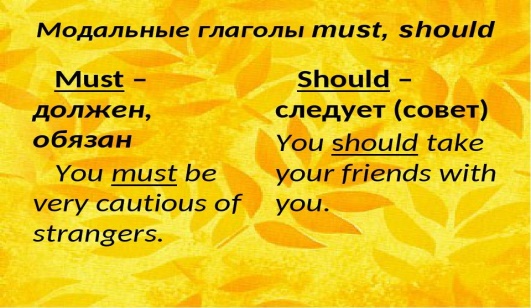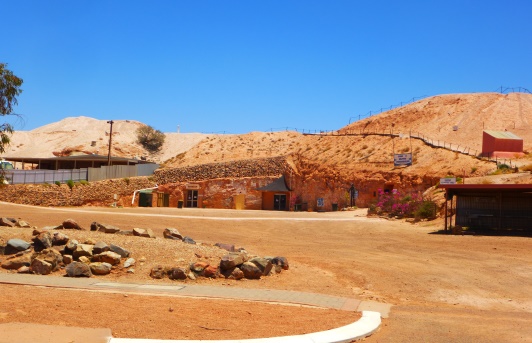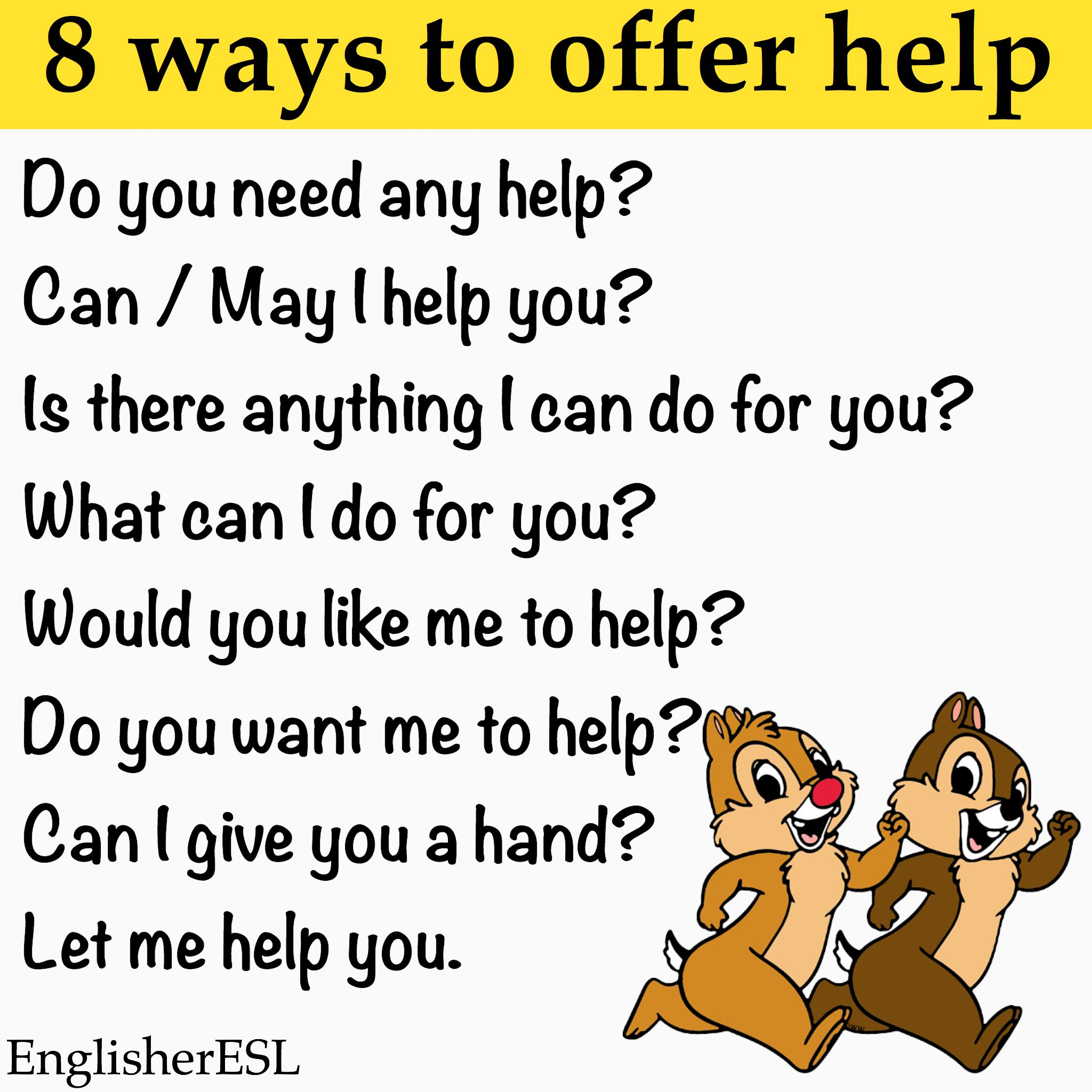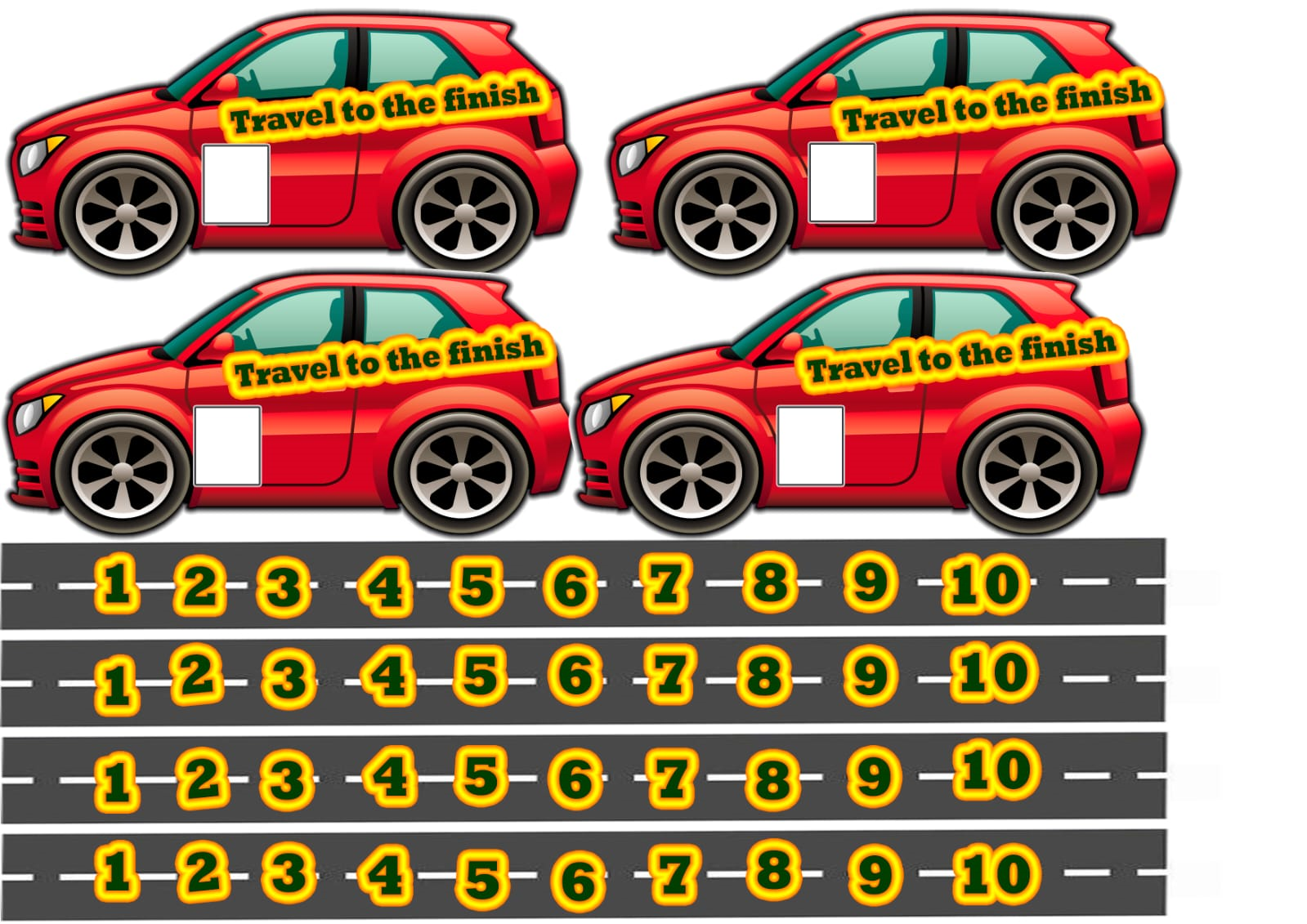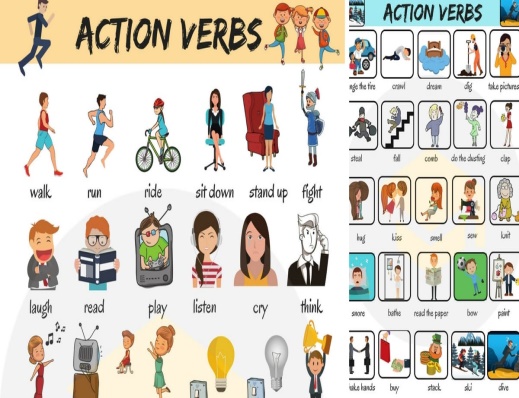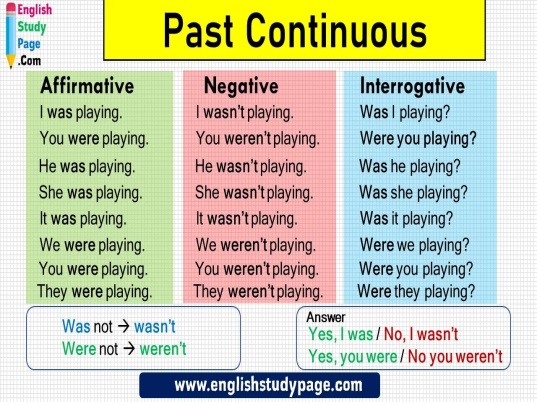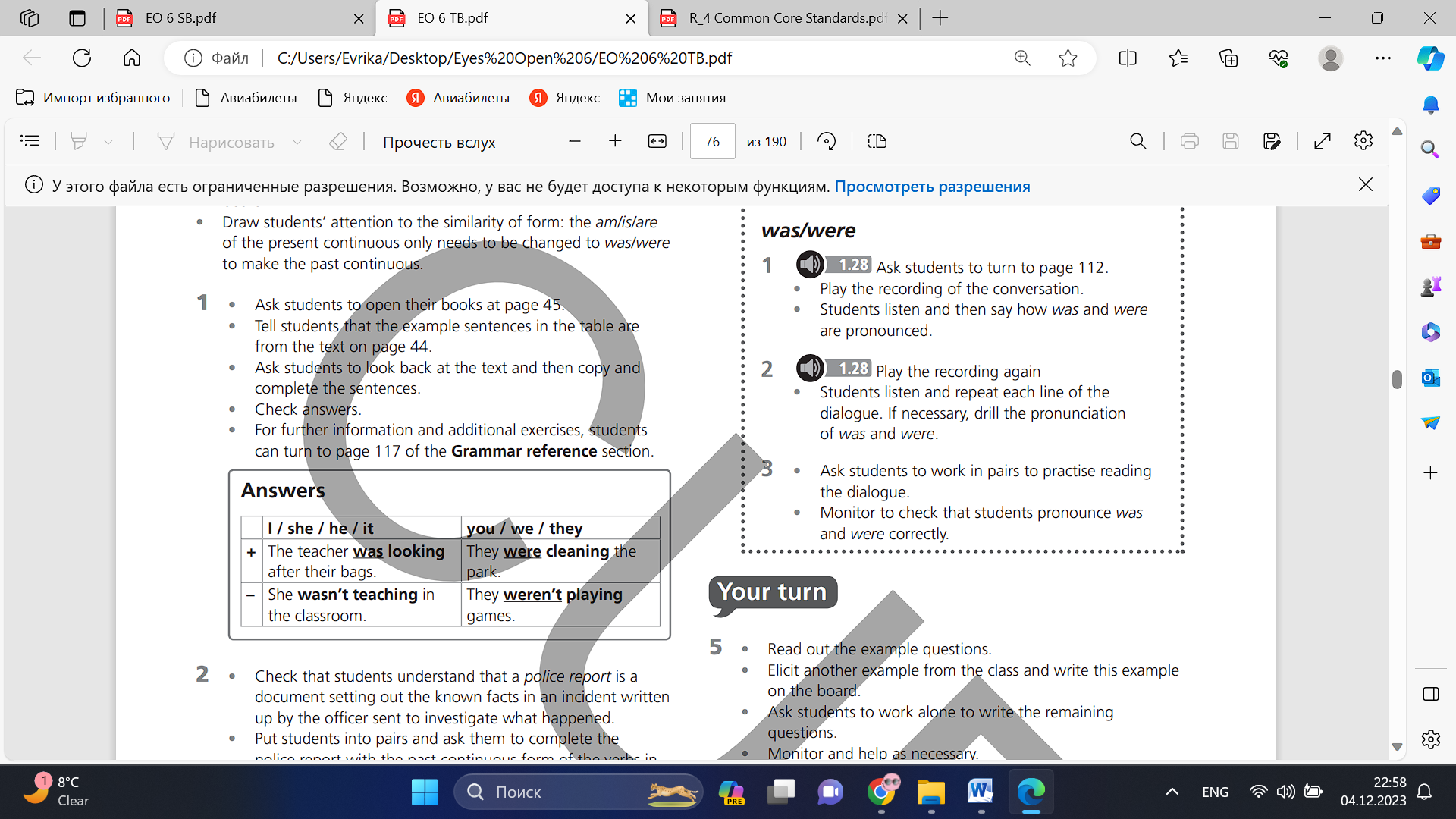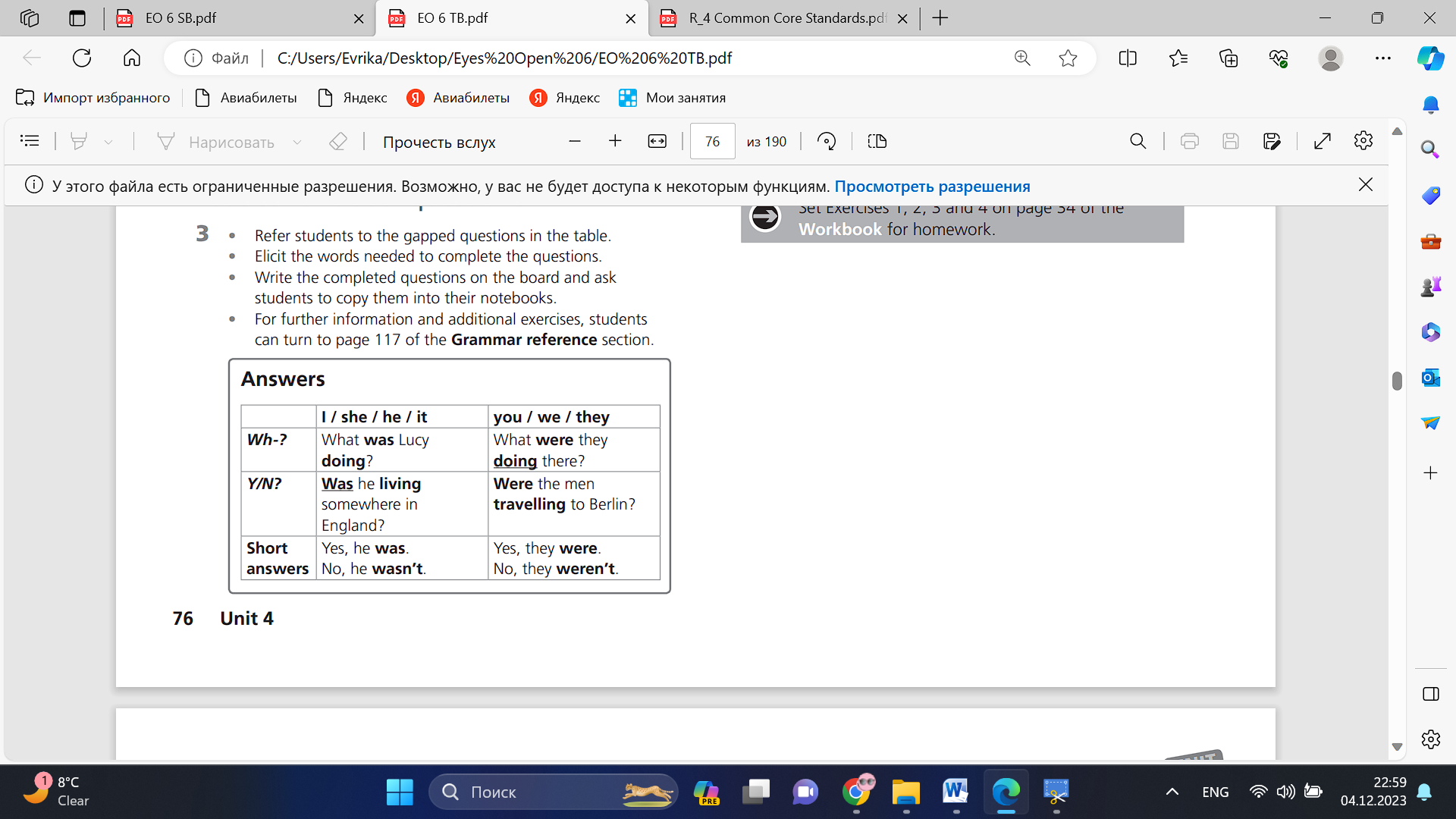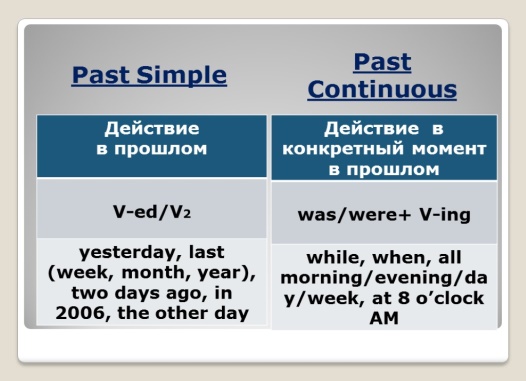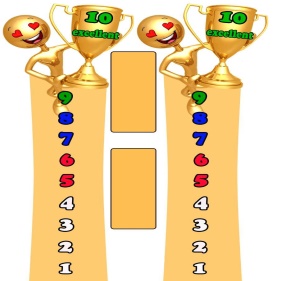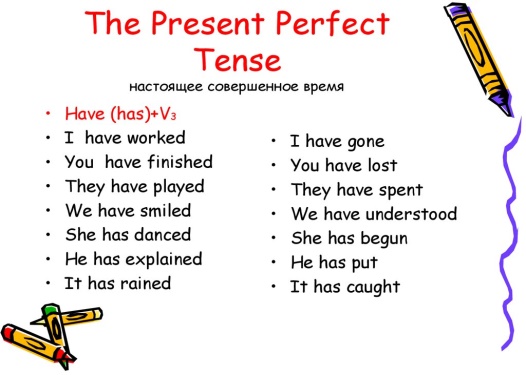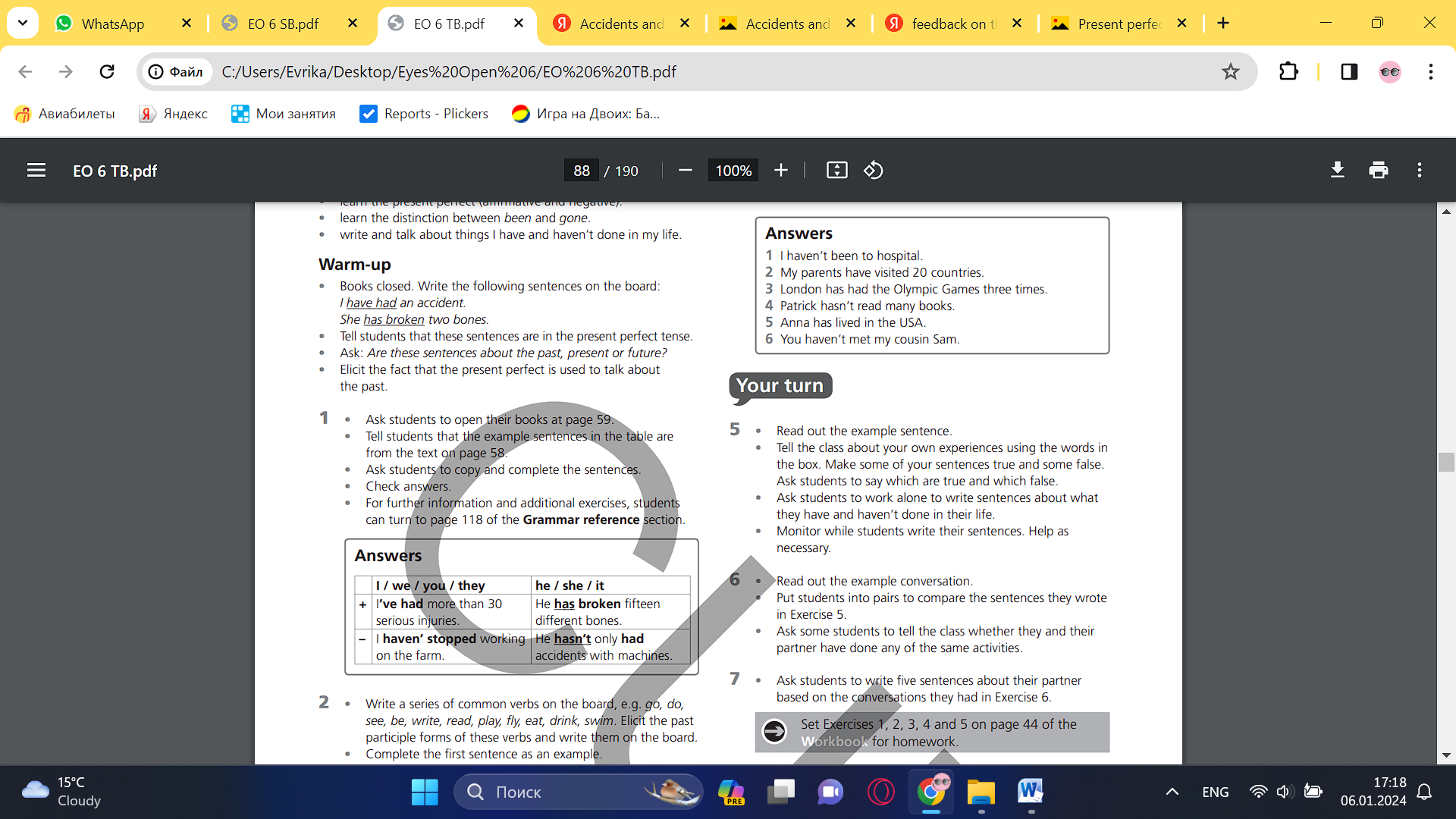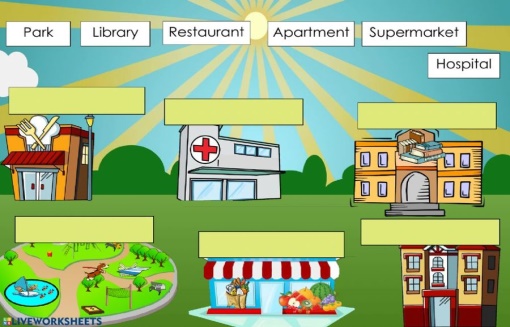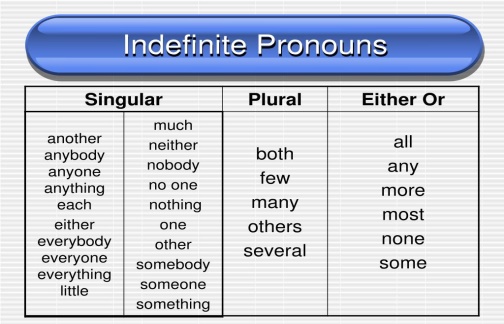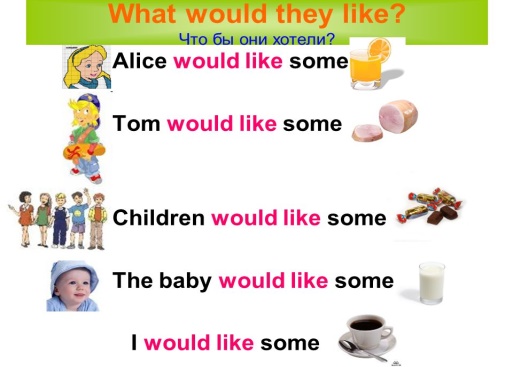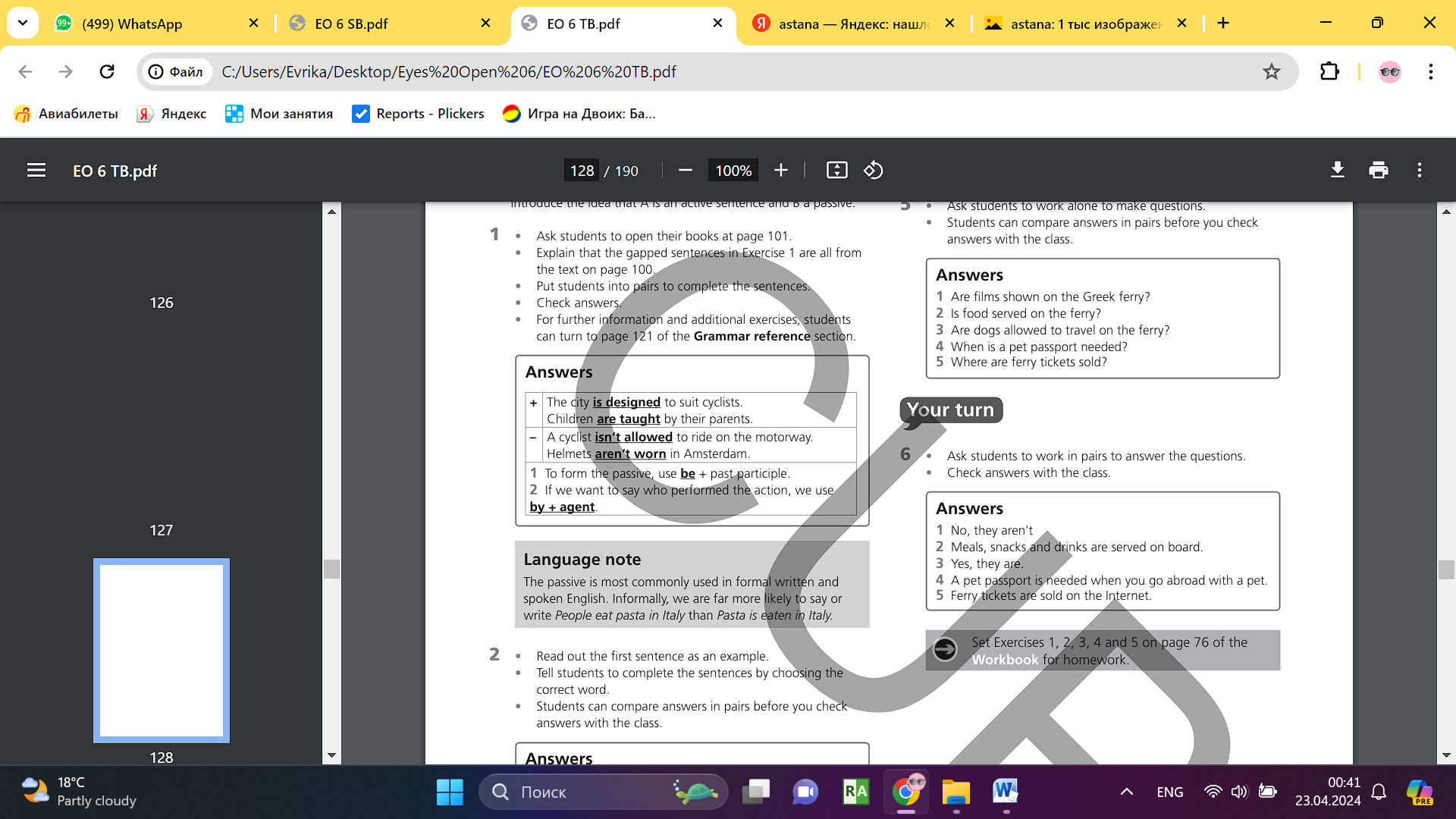Бұл материал сайт қолданушысы жариялаған. Материалдың ішінде жазылған барлық ақпаратқа жауапкершілікті жариялаған қолданушы жауап береді. Ұстаз тілегі тек ақпаратты таратуға қолдау көрсетеді. Егер материал сіздің авторлық құқығыңызды бұзған болса немесе басқа да себептермен сайттан өшіру керек деп ойласаңыз осында жазыңыз

Бонусты жинап картаңызға (kaspi Gold, Halyk bank) шығарып аласыз
1 жыл бойы тегін жүктеу мүмкіндігіне ие болыңыз!

жеңілдік
Eyes open 6 grade 2-3-4 тоқсан ҚМЖ жинағы .docx

Short term plan: term 2
|
Stages / Time |
Teachers actions |
Students actions |
Assessment criteria |
Resources |
|
Beginning of the lesson Warming-up
3 min. Pre-learning «Brainstorming» method 7 min.
|
Organization moment : 1.Greeting. Ask about the weather. The teacher sets the lesson objectives, letting students know what to anticipate from the lesson. Warming up Where are you from? How old are you? What color is it? How many students are there in class? What day of the week today? Hand out the completed Progress Report Cards for the previous module and ask the pupils to file them in their language. Lead – In
|
The aim: To develop pupils speaking skills and create friendly atmosphere Efficiency: By wishing each other they feel better and feel the support of others Students of the class are listed. Students' attention is drawn to the lesson. Students say different words from the picture •Learners remember previous lesson vocabulary •Learners answer the questions What time do you get up every morning? What time do you go to school? What do you do after the lesson? |
The teacher to assess learners for their ability. “Good job! Well done!” Formative Assessment
Good job! Descriptor: - remembers the lesson passed Point 1 Assessment criteria make basic statements related to personal information, match places to continents |
Pictures worksheet Picture |
|
Middle of the lesson Presentation part. 30 min
|
Ex:1 P:31 • Ask students to open their books at page 31. Use the pictures to revise the names of animals before students do the matching exercise. Students could also check how many of the words they mentioned in the warm- up are shown in the pictures. Put students into pairs to do the matching exercise. Weaker students can look up the meanings of the words in a dictionary. Ex: 2 P: 31 • Read out the items. Put students into pairs to find the animals from Exercise 1. Check answers. You could extend this by putting students into small groups and asking them to write three sentences similar to those in Exercise 2. You could then give those sentences to different groups to try and find the animals. Ex: 3 P: 31 • Ask students to describe the wild animals shown in Exercise 2. Elicit the words and phrases that students might need to use for this task and write them on the board, e.g. an animal with, it has/they have, lives in/on, etc. Give students time to make notes about the animal. Ex: 4 P: 31 •Put students into pairs to ask and answer questions. Students ask and answer questions to guess each other's animals. To extend the work on the vocabulary, you could ask students to turn to the Vocabulary bank on page 124 and do the exercises for Wild animals. Conclusion during the lesson some tasks differentiated by outcomes of the students and by their abilities. |
• Learners match the photos with the words in the box. Then listen, check and repeat ANSWERS a mouse b duck c seal d rabbit e camel f bear g deer h snow leopard I insect j wolf k gazelle 0 I snake • Learners find these animals from the list in Exercise 1. Try not to name any animal more than once ANSWERS 1 duck, seal 2 rabbit, camel, deer, gazelle 3 insect 4 mouse 5 bear, snow leopard, wolf, snake • Learners choose two animals from Exercise 1 and write notes about them. Think about these things: ANSWERS Students own answer • Learners work with a partner. Ask questions and try to guess your partner’s animals. ANSWERS Students own answer |
Descriptor: - match the photos with the words
T
Self assessment Differentiation: «Verbal support» method is used to help Ss use new words in the sentences. Descriptor: - find these animals from the list Total: 3 point Descriptor: - choose two animals Total: 3 point Descriptor: - work with a partner. - ask questions and try to guess Total: 3 point -Make CCQ questions Yes / No
|
Card Worksheet Students book |
|
End of the lesson 5 min |
FEEDBACK Learners provide feedback on what they have learned at the lesson. Ex: P: Home task: Write the days |
|
Poster Success
|
|
Short term plan: term 2
|
Unit 3 Our Countryside |
Lesson 26 |
||
|
Teacher name: |
|
||
|
Date: |
|
||
|
Grade: 6 |
Number present: |
absent: |
|
|
Lesson title |
Reading: An online forum |
||
|
Learning objectives |
6.1.7.1 develop and sustain a consistent argument when speaking or writing 6.4.2.1 understand specific information and detail in texts on a growing range of familiar general and curricular topics, including some extended texts 6.3.3.1 give an opinion at sentence level on a limited range of general and curricular topics |
||
|
Value links |
Loyalty – Loyalty might be a core personal value to you if you highly prize friends that are reliable and trustworthy. You might put your friends or chosen family first, always being there for them when they need you. |
||
|
Lesson objectives |
Learners will be able to: - read an online forum about unusual countryside hotels. - learn expressions with do. - describe an idea for an unusual hotel. |
||
|
Plan |
|||
|
Stages / Time |
Teachers actions |
Students actions |
Assessment criteria |
Resources |
|
Beginning of the lesson Warming-up
3 min Pre-learning «Brainstorming» method 7 min.
|
Organization moment : 1.Greeting. Ask about the weather. The teacher sets the lesson objectives, letting students know what to anticipate from the lesson. Warming up Where are you from? How old are you? What color is it? How many students are there in class? What day of the week today? Ask a few pupils to stand up and stand in a row. Ask the rest of the class questions to revise the ordinals. Lead – In
|
The aim: To develop pupils speaking skills and create friendly atmosphere Efficiency: By wishing each other they feel better and feel the support of others Students of the class are listed. Students' attention is drawn to the lesson. Determines the topic and purpose of the lesson •Learners remember previous lesson vocabulary Students say different words from the picture Answer the question.
|
The teacher to assess learners for their ability. “Good job! Well done!” Formative Assessment
Good job! Descriptor: - know daily routines vocabulary - know prepositions of place Point 1 Assessment criteria - Learners have met the learning objectives if they can talk about numbers and location; |
Pictures worksheet Student’s book |
|
Middle of the lesson Presentation part. 30 min
|
Ex:1 P:32 • Ask students to open their books at page 32. Students look at the photos and say what is unusual about each of the hotels pictured. Help students with vocabulary as necessary, but do not confirm or reject students' ideas as they will read the text in Exercise 2 to check them. Ex: 2 P: 32 • Ask students to read the online forum to check the ideas they came up with in Exercise 1. Students then match the posts with the pictures • Check answers and then refer students to the information in the FACT! box. Check that students understand that a capsule refers to a small case or a container. Ask students to find some photos of capsule hotels online and then ask: Would you like to stay in one of these rooms? Why? Why not? Ex: 3 P: 32 • Ask students to read the forum again. Put students into pairs and ask them to decide which of the three hotels described in the forum each of the sentences refers to. Check answers. Ex: 4 P: 32 • Ask students to find two examples of phrases with do in the text. Check answers. |
• Pupils work with a partner. What’s unusual about the hotels in the photos? ANSWERS Hotel 1 is the world's largest hotel made of snow and ice Hotel 2 has got underwater rooms. Hotel 3 is a tree house hotel. • Pupils read the online forum and check your ideas for Exercise 1. Then match the photos to the posts ANSWERS 1 c 2 a 3 b • Pupils read the online forum again. Match the sentences with the hotels they describe ANSWERS 2 Hotel 1 3 Hotel 3 4 Hotel 3 5 Hotel 2 6 Hotel 1 Pupils find two examples of do in the text. Which words follow them? ANSWERS do sports, do nothing nouns |
Descriptor: - work with a partner. - answer the question Total: 2 point pupils are evaluated by collecting fish
Descriptor: - read the online forum - match the photos to the posts Total: 1 point Descriptor: - read the online forum again - match the sentences with the hotels they describe Total: 2 point
Self assessment Descriptor: - find two examples of do in the text Total: 2 point -Make CCQ questions Yes / No Total: 10 point |
Card Worksheet Students book |
|
End of the lesson 5 min |
FEEDBACK Learners provide feedback on what they have learned at the lesson. Ex: P: Home task: Write the days |
|
Poster Success
|
|
Short term plan: term 2
|
Unit 3 Our Countryside |
Lesson 27 |
||
|
Teacher name: |
|
||
|
Date: |
|
||
|
Grade: 6 |
Number present: |
absent: |
|
|
Lesson title |
Language focus 1 Comparatives |
||
|
Learning objectives |
6.1.6.1 organise and present information clearly to others 6.5.2.1 write with minimal support about real and imaginary present events, activities and experiences happening now on a range of familiar general topics and some curricular topics 6.3.2.1 ask simple questions to get information about a limited range of general topics |
||
|
Lesson objectives |
Learners will be able to: - learn comparatives and superlatives. - describe a picture of my dream hotel room. |
||
|
Value links |
Fairness – If you value fairness, you might be highly sensitive to situations at school or in the workplace where a teacher or a peer has exhibited favoritism or allowed someone to get away with living by a different set of rules to everyone else. |
||
|
Plan |
|||
|
Stages / Time |
Teachers actions |
Students actions |
Assessment criteria |
Resources |
|
Beginning of the lesson Warming-up
3 min Pre-learning «Brainstorming» method 7 min.
|
Organization moment : 1.Greeting. Ask about the weather. The teacher sets the lesson objectives, letting students know what to anticipate from the lesson. Warming up Where are you from? How old are you? What color is it? How many students are there in class? What day of the week today? revise the vocabulary from the previous Lead – In
|
. The aim: To develop pupils speaking skills and create friendly atmosphere Efficiency: By wishing each other they feel better and feel the support of others Students of the class are listed. Students' attention is drawn to the lesson. • Learners remember previous lesson vocabulary Determines the topic and purpose of the lesson Students say different words from the picture
|
The teacher to assess learners for their ability. “Good job! Well done!” Formative Assessment
Good job! Descriptor: - can tell the time Point 1 Assessment criteria - Learners have met the learning objectives if they can talk about persons character
|
Pictures worksheet Picture |
|
Middle of the lesson Presentation part. 30 min
|
Ex:1 P: 33 • Ask students to open their books at page 33. Tell students that the example sentences in the table are from the text on page 32. Ask students to look back at the text and then copy and complete sentences 1-4. Check answers. For further information and additional exercises, students can turn to page 116 of the Grammar reference section Ex: 2 P: 33 • Read out the example. Ask students to work in pairs to complete the sentences b putting the adjective or adverb into the comparative. Check answers. Ex: 3 P: 33 • Tell students that the example sentences in the table are from the text on page 32. Ask students to look back at the text and then copy and complete sentences 5-7. Check answers. For further information and additional exercises, students can turn to page 116 of the Grammar reference section. Ex: 4 P: 33 • Read out the example. Ask students to work alone to write superlative sentences Conclusion during the lesson some tasks differentiated by outcomes of the students and by their abilities. |
•Pupils complete examples from the text ANSWERS
ANSWERS 2 more exciting 3 better 4 bigger 5 more easily 6 is noisie •Pupils complete examples in the table above ANSWERS
•Pupils write superlative sentences to complete the quiz. Then mark the sentences true (T) or false (F) ANSWERS 2 Kilimanjaro is the highest mountain in the world. (F) 3 Death Valley in California is the hottest place in the world. (T) 4 The Atlantic is the largest ocean in the world. (F) 5 The Vatican is the smallest country in the world. (T) 6 The cheetah is the fastest animal in the world. (F) 7 The elephant is the heaviest animal in the world. (F) |
Descriptor: - complete examples from the text Total: 1 point
Descriptor: - complete the sentences with the comparative form of the adjective or adverb in brackets Total: 1 point
Descriptor: - complete examples in the table above Total: 1 point Descriptor: - write superlative sentences to complete the quiz. Total: 1 point -Make CCQ questions Yes / No
pupils are evaluated by collecting pencils |
Card Worksheet
|
|
End of the lesson 5 min |
FEEDBACK Learners provide feedback on what they have learned at the lesson. Ex: Home task: |
|
Poster Success
|
|
Short term plan: term 2
|
Unit 3: Our Countryside |
Lesson 28 |
||
|
Teacher name: |
|
||
|
Date: |
|
||
|
Grade: 6 |
Number present: |
absent: |
|
|
Lesson title |
Listening A radio interview |
||
|
Learning objectives |
6.1.1.1 use speaking and listening skills to solve problems creatively and cooperatively in groups 6.3.7.1 use appropriate subject-specific vocabulary and syntax to talk about a range of general topics, and some curricular topics 6.2.2.1 understand with little or no support most specific information in extended talk on a wide range of general and curricular topics |
||
|
Lesson objectives |
Learners will be able to: - listen to an interview with a ranger at Yellowstone National Park. - learn about the countryside. - talk about looking after the countryside. |
||
|
Value links |
Honesty – You may highly value telling people the truth. This one gets tricky when being honest can be hurtful to others. So, a person who really puts honesty first might be the sort of person who will tell the truth even if it hurts to do so. |
||
|
Plan |
|||
|
Stages / Time |
Teachers actions |
Students actions |
Assessment criteria |
Resources |
|
Beginning of the lesson Warming-up
3 min Pre-learning «Brainstorming» method 7 min.
|
Organization moment : 1.Greeting. Ask about the weather. The teacher sets the lesson objectives, letting students know what to anticipate from the lesson. Warming up Where are you from? How old are you? What color is it? How many students are there in class? What day of the week today? revise the language from the previous lesson Lead – In
|
The aim: To develop pupils speaking skills and create friendly atmosphere Efficiency: By wishing each other they feel better and feel the support of others Students of the class are listed. Students' attention is drawn to the lesson. • Learners talk about daily routines previous lesson vocabulary Determines the topic and purpose of the lesson Students say different words from the picture
|
The teacher to assess learners for their ability. “Good job! Well done!” Formative Assessment
Good job! Descriptor: - talk about daily routines Point 1 Assessment criteria - Learners have met the learning objectives if they can talk about natural features |
Pictures worksheet Student’s book |
|
Middle of the lesson Presentation part. 30 min
|
Ex:1 P:34 • Ask students to open their books at page 34. Students look at the photos and answer the questions. Ex: 2 P: 34 • Tell students they are going to listen to an interview with Dave. Play the recording for students to listen and check the ideas they come up with in Exercise 1. Ex: 3 P: 34 • Give students time to read through the sentences. Play the recording. Students listen and mark the sentences. Students can compare answers in pairs before you check answers with the class. Ex: 4 P: 34 • Refer students to the words and phrases in the box. Weaker students can look up the meanings of the words in a dictionary. Students look at the pictures and complete the texts. Play the recording for students to listen, check their answers and repeat the words. |
•Pupils look at the pictures. What do you think the man’s job is and what do you think he has to do? Is the animal in the photo ever dangerous for people? ANSWERS Students own answer •Pupils listen to the interview. Check your answers ANSWERS He is a ranger in a national park. He has to make sure people follow the rules and help if they get into trouble. The animals are wild and they can attack humans. •Pupils listen again. Look at the two situations and mark the sentences ✓ (Do this) or ✗ (Don’t do this). ANSWERS 1 ✔ 2 x 3 x 4 ✔ 5 x 6 x 7✔ 8X •Pupils complete the sentences with the words in the box. You may need to change the form of some words. Then listen, check and repeat. ANSWERS 2 valley 3 hedge 4 wildlife 5 river bank 6 wood 7 keeping to the path 8 keeping her dog on a lead 9 shut the gate 10 throw your litter in the bin |
Descriptor: - look at the pictures -answer the question Total: 2 point
Descriptor: - listen to the interview Total: 2 point
pupils are evaluated by collecting colour pencils Descriptor: - complete the sentences with the words Total: 3 point
-Make CCQ questions Yes / No Total: 10 point |
Card Worksheet Students book |
|
End of the lesson 5 min |
FEEDBACK Learners provide feedback on what they have learned at the lesson. Ex: Home task: |
|
Poster Success
|
|
Short term plan: term 2
|
Unit: 3 Our Countryside |
Lesson 29 |
||
|
Teacher name: |
|
||
|
Date: |
|
||
|
Grade: 6 |
Number present: |
absent: |
|
|
Lesson title |
Language focus 2 must/mustn’t, should/shouldn’t |
||
|
Learning objectives |
6.1.6.1 organise and present information clearly to others 6.5.2.1 write with minimal support about real and imaginary past events, activities and experiences on a range of familiar general topics and some curricular topics |
||
|
Lesson objectives |
Learners will be able to: - learn must/mustn't and should/shouldn't. - write sentences about my obligations |
||
|
Value links |
Generosity – This may be a core value of yours if you cherish people who will give their time and resources to people in need. You may consider yourself to be a generous person if you find joy and meaning in giving to others. |
||
|
Plan |
|||
|
Stages / Time |
Teachers actions |
Students actions |
Assessment criteria |
Resources |
|
Beginning of the lesson Warming-up
3 min Pre-learning «Brainstorming» method 7 min.
|
Organization moment : 1.Greeting. Ask about the weather. The teacher sets the lesson objectives, letting students know what to anticipate from the lesson. Warming up Where are you from? How old are you? What color is it? How many students are there in class? What day of the week today? Revise the vocabulary from the previous lesson Lead – In
|
The aim: To develop pupils speaking skills and create friendly atmosphere Efficiency: By wishing each other they feel better and feel the support of others Students of the class are listed. Students' attention is drawn to the lesson. • Learners talk about days of the week previous lesson vocabulary Determines the topic and purpose of the lesson Students say different words from the picture
|
The teacher to assess learners for their ability. “Good job! Well done!” Formative Assessment
Good job! Descriptor: - talk about days of the we Total: 1 point Assessment criteria - Learners have met the learning objectives if they can talk about your last I holidays. |
Pictures worksheet picture |
|
Middle of the lesson Presentation part. 30 min
|
Ex:1 P:35 • Ask students to open their books at page 35. Tell students that the example sentences are from the listening on page 34. Ask them to copy the sentences into their notebooks and complete them with must or mustn't. Check answers. Ex: 2 P: 35 • Complete the rules with the class as a whole. Check that students understand the distinction between the words. You can do this by eliciting example sentences with must and mustn't. For further information and additional exercises, students can turn to page 116 of the Grammar reference section. Ex: 3 P: 35 • Ask students to work alone to choose the correct word in each sentence. Check answer Ex: 4 P: 35 • Tell students that the example sentences are from the listening on page 34. Ask them to copy the sentences and complete them with should or shouldn't. Check answers. |
• Pupils complete the examples from the listening ANSWERS +You must put all your food inside your car. - You mustn't run! • Pupils look at the sentences in Exercise 1. Then complete the rules with must or mustn’t. ANSWERS We use must to say you need to do something. We use mustn't to say that you can't do something. • Pupils choose the correct words ANSWERS 1 must 2 must 3 mustn't 4 must 5 mustn't 6 must • Pupils complete the examples from the listening ANSWERS +People sometimes think they should climb a tree. -You shouldn't make a noise or wave your arms. |
Descriptor: - complete the examples from the listening Total: 3 point Descriptor: - complete the rules with must or mustn’t Total: 2 point Descriptor: - choose the correct words Total: 2 point Descriptor: - complete the examples from the listening Total: 2 point
pupils are evaluated by collecting fish
-Make CCQ questions Yes / No Total: 10 point |
Card Worksheet Vocabulary card |
|
End of the lesson 5 min |
FEEDBACK Learners provide feedback on what they have learned at the lesson. Ex: Home task: |
|
Poster Success
|
|
Short term plan: term 2
|
Unit 3 Our Countryside |
Lesson 30 |
||
|
Teacher name: |
|
||
|
Date: |
|
||
|
Grade: 6 |
Number present: |
absent: |
|
|
Lesson title |
Discover Culture |
||
|
Learning objectives |
6.1.9.1 use imagination to express thoughts, ideas, experiences and feelings 6.2.1.1 understand with little or no support the main points in extended talk on a wide range of general and curricular topics. 6.3.7.1 use appropriate subject-specific vocabulary and syntax to talk about a range of general topics, and some curricular topics |
||
|
Lesson objectives |
Learners will be able to: - watch a video about living in Coober Pedy. - compare living in my country in the summer and winter |
||
|
Value links |
Generosity – This may be a core value of yours if you cherish people who will give their time and resources to people in need. You may consider yourself to be a generous person if you find joy and meaning in giving to others. |
||
|
Plan |
|||
|
Stages / Time |
Teachers actions |
Students actions |
Assessment criteria |
Resources |
|
Beginning of the lesson Warming-up
3 min Pre-learning «Brainstorming» method 7 min.
|
Organization moment : 1.Greeting. Ask about the weather. The teacher sets the lesson objectives, letting students know what to anticipate from the lesson. Warming up Where are you from? How old are you? What color is it? How many students are there in class? What day of the week today? Revise the language of the previous lesson. Lead – In
|
The aim: To develop pupils speaking skills and create friendly atmosphere Efficiency: By wishing each other they feel better and feel the support of others Students of the class are listed. Students' attention is drawn to the lesson. Determines the topic and purpose of the lesson • Learners talk about favourite dayprevious lesson vocabulary Students say different words from the picture and count one to hundred
|
The teacher to assess learners for their ability. “Good job! Well done!” Formative Assessment
Good job! Descriptor: - talk about favourite day Total: 1 point Assessment criteria - Learners have met the learning objectives if they can talk about natural wonders. |
Pictures worksheet Student’s book |
|
Middle of the lesson Presentation part. 30 min
|
Ex:1 P:36 • Ask students to open their books at page 36 and look at the images. Put students into pairs to answer the questions Ex: 2 P: 36 • Play the video for students to check their answers from Exercise 1. Ex: 3 P: 36 • Ask students to look at the words in the box. Put students into pairs to decide which of the things referred to in the box can be seen in the video. Check answers. To extend this activity, ask students to say something about the context in which each of the things is shown. Ex: 4 P: 36 Play the video again. Put students into pairs to complete the sentences with the correct words. Make sure that students understand that they can use up to, but not more than, three words to fill each gap. Check answers. |
Pupils work with a partner. Look at the pictures. Ask and answer the questions. ANSWERS Students own answer Pupils watch the video and check your answers to Exercise 1 ANSWERS 1 People live underground. 2 It's really hot there in the summer. Pupils test your memory. Which of the things below can you see in the video? ANSWERS golf cave bedroom mines trucks diggers precious stone Pupils watch the video again. Check your answers to Exercise 3 and complete the sentences with up to three words ANSWERS 2 old mine 3 only 20°C 4 1,500 5 opals 6 underground |
Descriptor: - work with a partner Total: 2 point
Self assessment Descriptor: - watch the video and check your answers Total: 3 point Descriptor: - watch the video again. Total: 3 point pupils are evaluated by collecting colour pencils
-Make CCQ questions Yes / No Total: 10 point |
Card Worksheet Students book |
|
End of the lesson 5 min |
FEEDBACK Learners provide feedback on what they have learned at the lesson. Ex: Home task: |
|
Poster Success
|
|
Short term plan: term 2
|
Unit 3: Our Countryside |
Lesson 31 |
||
|
Teacher name: |
|
||
|
Date: |
|
||
|
Grade: 6 |
Number present: |
absent: |
|
|
Lesson title |
Reading A blog |
||
|
Learning objectives |
6.3.7.1 use appropriate subject-specific vocabulary and syntax to talk about a range of general topics, and some curricular topics 6.5.6.1 link independently, sentences into coherent paragraphs using a variety of basic connectors on a range of familiar general topics and some curricular topics |
||
|
Lesson objectives |
Learners will be able to: - pronounce words and phrases correctly -write a coherent paragraph /short text stating and explaining an idea, or describing a place, object |
||
|
Value links |
Integrity – Integrity is the quality of having strong moral principles. So, a person with integrity will always act with honesty and adhere to their own moral code regardless of what others do. |
||
|
Plan |
|||
|
Stages / Time |
Teachers actions |
Students actions |
Assessment criteria |
Resources |
|
Beginning of the lesson Warming-up
3 min Pre-learning «Brainstorming» method 7 min.
|
Organization moment : 1.Greeting. Ask about the weather. The teacher sets the lesson objectives, letting students know what to anticipate from the lesson. Warming up Hot Potato Students stand in a circle and pass an object around. When the timer goes off, or the music stops, the student holding the hot potato has to do something. Revise the language of the previous lesson. Lead – In
|
The aim: To develop pupils speaking skills and create friendly atmosphere Efficiency: By wishing each other they feel better and feel the support of others Students of the class are listed. Students' attention is drawn to the lesson. • Learners write the numbers from previous lesson Determines the topic and purpose of the lesson Students say different words from the picture What is the temperature in Kazakhstan?
|
The teacher to assess learners for their ability. “Good job! Well done!” Formative Assessment
Good job! Descriptor: -know key phrases - know vocabulary of previous lesson Total: 1 point Assessment criteria - Learners have met the learning objectives if they can: To talk about |
Pictures worksheet Student’s book |
|
Middle of the lesson Presentation part. 30 min
|
Ex:1 P:37 • Ask students to open their books at page 37. Put students into pairs to look at the photos and answer th two questions. Do not confirm or reject students' ideas at this point. Students will check their answers in Exercise 2 Ex: 2 P: 37 • Ask students to read the blog to check their answers to Exercise 1. Ex: 3 P: 37 • Give students time to read through the text again. Put students into pairs to choose the correct answer in each sentence. Check answers. Ex: 4 P: 37 Ask students to finds two phrasal verbs in the text with up or down. Then ask students if they can work out the meaning of these verbs by looking at the context. Check answers and then remind students that phrasal verbs are a common feature of informal spoken and written English. Ex: 5 P: 37 Read out the example sentence. Ask students to work in pairs to complete the sentences with the verb in brackets and up or down. Conclusion during the lesson some tasks differentiated by outcomes of the students and by their abilities. |
Pupils look at the map and pictures. Where is Barrow? What do you think the weather is like there? ANSWERS Students own answer Pupils read John’s blog. Check your ideas to Exercise 1 ANSWERS Barrow is in Alaska. It's very cold and dark there Pupils read the blog again and choose the correct answer. ANSWERS 1 any other town in the USA 2 lower than 0°C 3 light 4 stay in Barrow 5 a festival Pupils look at the blog again. Find two verbs with up or down. What do they mean ANSWERS go down = (about the sun) move down so that it cannot be seen come up appear, rise Pupils complete the sentences with the verb in brackets and up or down ANSWERS 2 put up 3 lie down 4 go up 5 Come down |
Descriptor: - look at the map and pictures - answer the question. Total: 2 point Descriptor: - read John’s blog Total: 3 point Descriptor: - read the blog - choose the correct answer. Total: 2 point
pupils are evaluated by collecting fish
Descriptor: - complete the sentences with the verb -Make CCQ questions Yes / No |
Card Worksheet Students book |
|
End of the lesson 5 min |
FEEDBACK Learners provide feedback on what they have learned at the lesson. Ex: Home task: |
|
Poster Success
|
|
Short term plan: term 2
|
Unit 3: Our Countryside |
Lesson 32 |
||
|
Teacher name: |
|
||
|
Date: |
|
||
|
Grade: 6 |
Number present: |
absent: |
|
|
Lesson title |
Speaking Asking for and offering help |
||
|
Learning objectives |
6.1.3.1 respect differing points of view 6.2.6.1 deduce meaning from context in short, supported talk on an increasing range of general and curricular topics 6.4.6.1 recognise the attitude or opinion of the writer on a growing range of unfamiliar general and curricular topics, including some extended texts |
||
|
Lesson objectives |
Learners will be able to: - comprehend short talk that contains unfamiliar language and compensate lack of understanding when listening - identify how the author feels in short and simple texts and stories |
||
|
Value links |
Perseverance – People who value perseverance will work through adversity and be determined to get a result. This is a great treat for employees and entrepreneurs alike. |
||
|
Plan |
|||
|
Stages / Time |
Teachers actions |
Students actions |
Assessment criteria |
Resources |
|
Beginning of the lesson Warming-up 3 min Pre-learning «Brainstorming» method 7 min. |
Organization moment : 1.Greeting. Ask about the weather. The teacher sets the lesson objectives, letting students know what to anticipate from the lesson. Warming up Hot Potato Students stand in a circle and pass an object around. When the timer goes off, or the music stops, the student holding the hot potato has to do something. Revise the language of the previous lesson. Lead-in
|
The aim: To develop pupils speaking skills and create friendly atmosphere Efficiency: By wishing each other they feel better and feel the support of others Students of the class are listed. Students' attention is drawn to the lesson. • Learners talk about favourite day previous lesson vocabulary Determines the topic and purpose of the lesson Students say different words from the picture |
The teacher to assess learners for their ability. “Good job! Well done!” Formative Assessment
Good job! Descriptor: -know key phrases - can make sentence - know vocabulary of previous lesson Total: 1 point Assessment criteria - Learners have met the learning objectives if they can talk about asking for and offering help |
Pictures worksheet Student’s book |
|
Middle of the lesson Presentation part. 30 min |
Ex:1 P:38 • Ask students to open their books at page 38. Elicit a description of the photo e.g. A father and son are in their kitchen. The father is cooking. The son is laying the table. Tell students they are going to watch some teenagers answering the following question Which do you prefer - flats or houses? Tell students that they are going to note down which speakers prefer flats, which houses, and which like both Ex: 2 P: 38 • Put students into pairs to ask and answer the question. Ask some students to report back to the class on what their partner said Ex: 3 P: 38 • Tell students they are going to listen to Josh talking to his dad about housework. Read out the question. Play the recording. Students listen and answer the question. Check answer. Ex: 4 P: 38 • Refer students to the phrases in the Useful language box. Check students' understanding of the language, particularly the idioms to give someone a hand (which means to help someone with something) and to do someone a favour (which means to do something for someone because you want to help them rather than because there will be any benefit to you in doing it). Students can work alone to complete the conversation using the phrases in the Useful language box. Conclusion during the lesson some tasks differentiated by outcomes of the students and by their abilities. |
Pupils watch the teenagers in the video. Do they prefer ‑ ats (F), houses (H) or both (B)? Why? ANSWERS B H quieter C H flats are small, don't get much light d B e H usually have a garden F F you can be nearer to the city centre Pupils work with your partner. Which do you prefer – houses or ‑ ats? ANSWERS Students own answer. Pupils listen to Josh and his dad talking about housework. Which jobs does Josh agree to do? ANSWERS put the plates in the dishwasher Pupils complete the conversation with the useful language. Then listen and check your answers. ANSWERS 1 Can you give me a hand? 2 Shall | 3 Can you do me a favour? 4 I'll do it. 5 I'll give you a hand 6 Yes, of course |
Descriptor: - watch the teenagers in the video - complete the task Total: 2 point
Descriptor: - work with your partner - answer the question Total: 3 point Descriptor: - listen to Josh and his dad talking about housework - answer the question Total: 3 point
pupils are evaluated by collecting colour pencils Descriptor: - complete the conversation Total: 3 point -Make CCQ questions Yes / No Total: 10 point |
Card Worksheet Students book |
|
End of the lesson 5 min |
FEEDBACK Learners provide feedback on what they have learned at the lesson. Ex: Home task: |
|
Poster Success
|
|
Short term plan: term 2
|
Unit 3: Our Countryside |
Lesson 33 |
||
|
Teacher name: |
|
||
|
Date: |
|
||
|
Grade: 6 |
Number present: |
absent: |
|
|
Lesson title |
Writing A description of a favorite walk |
||
|
Learning objectives |
6.1.10.1 use talk or writing as a means of reflecting on and exploring a range of perspectives on the world 6.3.8.1 recount basic stories and events on a range of general and curricular topics ( describe vertebrates) 6.4.1.1 understand the main points in texts on a growing range of unfamiliar general and curricular topics, including some extended texts |
||
|
Lesson objectives |
Learners will be able to: - produce a narrative as a linear sequence of events - identify the central idea, the intended audience and the author’s purpose |
||
|
Value links |
Self-Discipline – If you value self-discipline, you might be a person who wakes up early, exercises daily, and doesn’t get distracted by vices. |
||
|
Plan |
|||
|
Stages / Time |
Teachers actions |
Students actions |
Assessment criteria |
Resources |
|
Beginning of the lesson Warming-up 3 min Pre-learning «Brainstorming» method 7 min. |
Organization moment : 1.Greeting. Ask about the weather. The teacher sets the lesson objectives, letting students know what to anticipate from the lesson. Warming up Hot Potato Students stand in a circle and pass an object around. When the timer goes off, or the music stops, the student holding the hot potato has to do something. Write some of the words from the previous lesson Lead – In
|
“The wish lamp” method helps to start the lesson with good wishes to each other. The aim: To develop pupils speaking skills and create friendly atmosphere Efficiency: By wishing each other they feel better and feel the support of others Students of the class are listed. Students' attention is drawn to the lesson. • Learners talk about rooms previous lesson vocabulary Determines the topic and purpose of the lesson Students say different words from the picture |
The teacher to assess learners for their ability. “Good job! Well done!” Formative Assessment
Good job! Descriptor: -know key phrases - can make sentence - know vocabulary of previous lesson Total: 1 point Assessment criteria - Learners have met the learning objectives if they can: Talk about favorite walk |
Pictures worksheet Student’s book |
|
Middle of the lesson Presentation part. 30 min |
Ex:1 P:37 • Ask students to open their books at page 39. Ask students to look at the picture, read Kevin's description his favourite walk, and say whether they would like to do it Ex: 2 P: 37 • Give students time to read Kevin's description again. Ask students to work in pairs to answer the questions. Check answers. Ex: 3 P: 37 • Read out the information in the Useful language box. Ask students to work alone to find examples of adjectives the text in Exercise. 1. Students can compare answers in pairs before you check answers with the class. Ex: 4 P: 37 • Read out the example. Put students into pairs to complete the box with the adjectives in the box. Check answers. Conclusion during the lesson some tasks differentiated by outcomes of the students and by their abilities. |
• Pupils look at the picture and read Kevin’s description of his favourite walk. Would you like to go for a walk there? ANSWERS Students own answer • Pupils read Kevin’s description again and answer the questions ANSWERS 1 by a river rabbits, deer 2 Because it's cool on hot days 3 ducks 4 You can walk (along the main road • Pupils look at the useful language box. Find examples of adjectives in Kevin’s description ANSWERS beautiful, big, cool, hot, new, green, blue, little, shy, easy • Pupils complete the table with the words in the box. ANSWERS 1 beautiful 2 small 3 old 4 green and yellow |
Descriptor: - look at the picture and read Kevin’s description - answer the question Total: 2 point
Self Assessment Descriptor: - read Kevin’s description again - answer the questions Total: 2 point Descriptor: - at the useful language box - find examples of adjectives Total: 2 point -Make CCQ questions Yes / No Total: 10 point |
Card Worksheet Students book |
|
End of the lesson 5 min |
FEEDBACK Learners provide feedback on what they have learned at the lesson. Ex: Home task: |
|
Poster Success
|
|
Short term plan: term 2
|
Unit 3 Our Countryside |
Lesson 34 |
||
|
Teacher name: |
|
||
|
Date: |
|
||
|
Grade: 6 |
Number present: |
absent: |
|
|
Lesson title |
CLIL: Science Lifecycle of a plastic bag |
||
|
Learning objectives |
6.1.5.1 use feedback to set personal learning objectives 6.3.7.1 use appropriate subject-specific vocabulary and syntax to talk about a range of general topics, and some curricular topics |
||
|
Lesson objectives |
Learners will be able to: - show control of their own learning - pronounce words and phrases correctly |
||
|
Value links |
Humility – You might highly value humility if you find yourself disgusted by people who are arrogant or braggadocious, and instead find yourself gravitating to people who are always expressing their gratefulness for the blessings in their life. |
||
|
Plan |
|||
|
Stages / Time |
Teachers actions |
Students actions |
Assessment criteria |
Resources |
|
Beginning of the lesson Warming-up 3 min Pre-learning «Brainstorming» method 7 min. |
Organization moment : 1.Greeting. Ask about the weather. The teacher sets the lesson objectives, letting students know what to anticipate from the lesson. Warming up Hot Potato Students stand in a circle and pass an object around. When the timer goes off, or the music stops, the student holding the hot potato has to do something. Lead – In
|
The aim: To develop pupils speaking skills and create friendly atmosphere Efficiency: By wishing each other they feel better and feel the support of others Students of the class are listed. Students' attention is drawn to the lesson. Learners find mime an action associated with one of the places Determines the topic and purpose of the lesson Students say different words from the picture |
The teacher to assess learners for their ability. “Good job! Well done!” Formative Assessment
Good job! Descriptor: -know key phrases - know vocabulary of previous lesson Total: 1 point Assessment criteria - Learners have met the learning objectives if they can: Talk about lifecycle of a plastic bag |
Pictures worksheet Student’s book |
|
Middle of the lesson Presentation part. 30 min |
Ex:1 P:40 • Ask students to open their books at page 40. Explain that a raw material is what a material is before it is processed or used to make something, eg Wood is a raw material that is used to make paper Ask students to look at the photos and decide which shows a raw material used in the manufacturing of plastic bags. Do not confirm students' ideas at this point. Ex: 2 P: 40 • Tell students they are going to listen to the first part of an interview with an expert on plastic. Play the recording. Ask students to check their answers to Exercise 1. Ex: 3 P: 40 • Before students listen to the interview again, check they can pronounce polyethylene /,polr'ɛ0rli:n/, which is a substance used in plastic bags. Also check students understanding of the verb extract, which means to remove something from somewhere, usually by force. Play the interview again. Students listen and complete the diagram by putting the words and phrases in the right order. Check answers. Ex: 4 P: 40 Play the second part of the recording. Students listen and choose the correct answer in each of the five sentences. Check answers Conclusion during the lesson some tasks differentiated by outcomes of the students and by their abilities. |
• Pupils look at the photos. Which do you think people use to make plastic bags? ANSWERS Students own answer • Pupils listen to the first part of an interview with an expert on plastic and check your ideas to Exercise 1 ANSWERS Oil • Pupils listen to the interview again and complete the diagram about making plastic bags. ANSWERS 1 extract oil 2 make polyethylene 3 make plastic bags 4 use 5 recycle • Pupils listen to the second part of the interview and choose the correct answers ANSWERS 1 three 2 once 3 100,000 4 non-biodegradable 5 1,000 |
Descriptor: - look at the photos. - answer the questions Total: 2 point
Descriptor: - listen to the first part of an interview - answer the question Total: 2 point Descriptor: - listen to the interview again - complete the diagram about making plastic bags. Total: 2 point
pupils are evaluated by collecting colour pencils Descriptor: - listen to the second part of the interview - choose the correct answers Total: 2 point -Make CCQ questions Yes / No |
Card Worksheet Students book |
|
End of the lesson 5 min |
FEEDBACK Learners provide feedback on what they have learned at the lesson. Ex: Home task: |
|
Poster Success
|
|
Short term plan: term 2
|
Unit 3 Our Countryside |
Lesson 35 |
||
|
Teacher name: |
|
||
|
Date: |
|
||
|
Grade:6 |
Number present: |
absent: |
|
|
Lesson title |
Extra reading: Protecting nature Summative assessment for the unit 3 |
||
|
Learning objectives |
6.1.5.1 use feedback to set personal learning objectives 6.2.6.1 deduce meaning from context in short, supported talk on an increasing range of general and curricular topics 6.6.10.1 use present continuous forms with present meaning on a limited range of familiar general and curricular topics |
||
|
Lesson objectives |
Learners will be able to: - use simple context clues strategies to identify meaning of unknown words from the context - use the present continuous tense to refer to events at the time of speaking |
||
|
Value links |
Kindness – If you value kindness, you’ll likely always be respectful of people around you, be gentle with criticism, and always willing to welcome people with open arms. |
||
|
Plan |
|||
|
Stages / Time |
Teachers actions |
Students actions |
Assessment criteria |
Resources |
|
Beginning of the lesson Warming-up 3 min Pre-learning «Brainstorming» method 7 min. |
Organization moment : 1.Greeting. Ask about the weather. The teacher sets the lesson objectives, letting students know what to anticipate from the lesson. Warming up Hot Potato Students stand in a circle and pass an object around. When the timer goes off, or the music stops, the student holding the hot potato has to do something. Revise the language of the previous lesson Lead – In
|
The aim: To develop pupils speaking skills and create friendly atmosphere Efficiency: By wishing each other they feel better and feel the support of others Students of the class are listed. Students' attention is drawn to the lesson. Learners find mime an action associated with one of the places Determines the topic and purpose of the lesson Students say different words from the picture |
The teacher to assess learners for their ability. “Good job! Well done!” Formative Assessment
Good job! Assessment criteria - Learners have met the learning objectives if they can: Talk about protecting nature Descriptor: -know key phrases - know vocabulary of previous lesson Total: 1 point |
Pictures worksheet Student’s book |
|
Middle of the lesson Presentation part. 30 min |
Ex:1 P:41 • Ask students to skim read the article to find out what it says about the animals in the photos. Check answers with the whole class. (They're all endangered species and they live in the Almaty Nature Reserve.) Write 7 on the board. Ask students to scan the text and find what this number refers to. Make sure they do this as fast as possible. Elicit the answer and where they found it in the text. (seven important nature reserves; first paragraph) Set a two-minute time limit for students to do the rest of the task. Remind them that they don't have to read every single word of the text. They can scan the text in any direction - left to right and vice versa, downwards or upwards. You could explain that this type of reading Ex: 2 P: 41 • Ask students to read the text again on their own. Students write five true or false sentences about the text. You could write one one the board as an example Ex: 3 P: 41 • Students work in pairs. They take turns to read a sentence to their partner, who must say whether the sentence is true or false and correct the false sentences. Ask students to try answering without referring to the text at first They can then check their answers by scanning the text. Summative assessment for the unit «Our countryside» Conclusion during the lesson some tasks differentiated by outcomes of the students and by their abilities. |
Pupils read the text, then match the numbers with the words ANSWERS 1 b 2f 3 h 4 9 5c 6 e 7 a 8 d Pupils read the text again. Write five true or false sentences using the information in the text. ANSWERS Students own answer Pupils work in pairs. Read your sentences to your partner. Can they remember whether each is true or false without looking at the text? Can they correct the false sentences? ANSWERS Students own answer |
Descriptor: - read the text - match the numbers with the words Total: 2 point
pupils are evaluated by collecting fish
Descriptor: - read the text again - write five true or false sentences Total: 2 point Descriptor: - work in pairs - read your sentences to your partner Total: 2point -Make CCQ questions Yes / No |
Card Worksheet Students book |
|
End of the lesson 5 min |
FEEDBACK Learners provide feedback on what they have learned at the lesson. Ex: Home task: |
|
Poster Success
|
|
Short term plan: term 2
|
Unit 4 Drama and comedy |
Lesson 36 |
||
|
Teacher name: |
|
||
|
Date: |
|
||
|
Grade:6 |
Number present: |
absent: |
|
|
Lesson title |
Vocabulary: Action verbs |
||
|
Learning objectives |
6.1.2.1 use speaking and listening skills to provide sensitive feedback to peers 6.3.7.1 use appropriate subject-specific vocabulary and syntax to talk about a range of general topics, and some curricular topics |
||
|
Lesson objectives |
Learners will be able to: - present constructive and impersonal feedback orally - differentiate and use the meaning, parts of speech and word forms accurately |
||
|
Value links |
Kindness – If you value kindness, you’ll likely always be respectful of people around you, be gentle with criticism, and always willing to welcome people with open arms. |
||
|
Plan |
|||
|
Stages / Time |
Teachers actions |
Students actions |
Assessment criteria |
Resources |
|
Beginning of the lesson Warming-up 3 min Pre-learning «Brainstorming» method 7 min. |
Organization moment : 1.Greeting. Ask about the weather. The teacher sets the lesson objectives, letting students know what to anticipate from the lesson. Warming up Hot Potato Students stand in a circle and pass an object around. When the timer goes off, or the music stops, the student holding the hot potato has to do something. Revise the language of the previous lesson Lead – In
|
The aim: To develop pupils speaking skills and create friendly atmosphere Efficiency: By wishing each other they feel better and feel the support of others Students of the class are listed. Students' attention is drawn to the lesson. Learners find mime an action associated with one of the places Determines the topic and purpose of the lesson Students say different words from the picture |
The teacher to assess learners for their ability. “Good job! Well done!” Formative Assessment
Good job! Assessment criteria - Learners have met the learning objectives if they can: Talk about protecting nature Descriptor: -know key phrases - know vocabulary of previous lesson Total: 1 point |
Pictures worksheet Student’s book |
|
Middle of the lesson Presentation part. 30 min |
Ex:1 P:43 • Ask students to open their books at page 43. Refer students to the picture story and ask students to describe what each panel in the picture story shows. Ask the question and then elicit the answer from the class. Play the recording for students to check their answers and repeat the words. Ex: 2 P: 43 • Read out the verbs in the box. Check that students are able to pronounce the verbs, particularly catch /kats/, climb /klım/ and throw /Orǝu/. Put students into pairs to match the verbs with the pictures in the story. Ex: 3 P: 43 • Ask one student to read out the example sentence. Ask students to work alone to complete the sentences with the past simple form of the verbs. Refer students to the irregular verb list on page 133 if necessary. Students can compare answers in pairs before you check answers with the class. Check that students are able to pronounce the verbs in their past simple form, particularly caught /kɔ:t/, hid /hid/ and threw /eru:/ Conclusion during the lesson some tasks differentiated by outcomes of the students and by their abilities. |
Pupils look at the story about a thief. What did the thief steal? ANSWERS a bag with money Pupils match the pictures with the words in the box. Then listen, check and repeat. ANSWERS a run away b chase c jump d throw e climb f hide g fall over h catch Pupils complete the sentences with the past simple form of the verbs in Exercise 2. ANSWERS 2 chased 3 jumped 4 threw 5 climbed 6 hid 7 fell over 8 caught |
Descriptor: - look at the story - answer the question. Total: 2 point
pupils are evaluated by collecting fish
Descriptor: - match the pictures with the words - listen, check and repeat. Total: 2 point Descriptor: - complete the sentences Total: 2 point -Make CCQ questions Yes / No |
Card Worksheet Students book |
|
End of the lesson 5 min |
FEEDBACK Learners provide feedback on what they have learned at the lesson. Ex: Home task: |
|
Poster Success
|
|
Short term plan: term 2
|
Unit 4 Drama and comedy |
Lesson 37 |
||
|
Teacher name: |
|
||
|
Date: |
|
||
|
Grade:6 |
Number present: |
absent: |
|
|
Lesson title |
Reading: A story |
||
|
Learning objectives |
6.1.2.1 use speaking and listening skills to provide sensitive feedback to peers 6.3.5.1 keep interaction going in basic exchanges on a growing range of general and curricular topics 6.4.2.1 understand with little support specific information and detail in short, simple texts on a limited range of general and curricular topics |
||
|
Lesson objectives |
Learners will be able to: - present constructive and impersonal feedback orally - differentiate and use the meaning, parts of speech and word forms accurately |
||
|
Value links |
Kindness – If you value kindness, you’ll likely always be respectful of people around you, be gentle with criticism, and always willing to welcome people with open arms. |
||
|
Plan |
|||
|
Stages / Time |
Teachers actions |
Students actions |
Assessment criteria |
Resources |
|
Beginning of the lesson Warming-up 3 min Pre-learning «Brainstorming» method 7 min. |
Organization moment : 1.Greeting. Ask about the weather. The teacher sets the lesson objectives, letting students know what to anticipate from the lesson. Warming up Hot Potato Students stand in a circle and pass an object around. When the timer goes off, or the music stops, the student holding the hot potato has to do something. Revise the language of the previous lesson Lead – In |
The aim: To develop pupils speaking skills and create friendly atmosphere Efficiency: By wishing each other they feel better and feel the support of others Students of the class are listed. Students' attention is drawn to the lesson. Learners find mime an action associated with one of the places Determines the topic and purpose of the lesson Students say different words from the picture |
The teacher to assess learners for their ability. “Good job! Well done!” Formative Assessment
Good job! Assessment criteria - Learners have met the learning objectives if they can: Talk about protecting nature Descriptor: -know key phrases - know vocabulary of previous lesson Total: 1 point |
Pictures worksheet Student’s book |
|
Middle of the lesson Presentation part. 30 min |
Ex:1 P:44 • Ask students to open their books at page 44. Ask students to look at the pictures. Help weaker studen by eliciting or teaching the following vocabulary which the can then use when thinking about what story the pictures show: passport, train carriage and police officer. Either elicit ideas from the class as a whole or put students into small groups to brainstorm ideas about the stay Ex: 2 P: 44 • Ask students to work alone to read the story to check the ideas they came up with in Exercise 1. Ex: 3 P: 44 • Refer students to the six questions. Put students into pairs and ask them to read the text again and answer the questions. Check answers. Encourage stronger students to give as much detail as possible in their answers Refer students to the information in the FACT! box. Find ou if any students have ever found anything that someone else had lost. Ex: 4 P: 44 Books closed. Write the verb look on the board, then elicit any expressions that students know using this verb. Students may know phrasal verbs such as look for, look after or look at something/someone. Ask students to open their books at page 44 and find four examples of look + preposition in the text. Conclusion during the lesson some tasks differentiated by outcomes of the students and by their abilities. |
Pupils work with a partner. Look at the pictures. What do you think happened in the story? ANSWERS Students own answer Pupils read the story and check your ideas for Exercise 1 ANSWERS Lucy Wilson and her friends found a large bag full of expensive objects Pupils read the text again and answer the questions ANSWERS 1 One afternoon last June. 2 Near the lake. 3. The teacher. 4 Ten minutes. 5 Expensive objects, e.g. watches, clocks and gold; a Hungarian passport, two train tickets to Berlin and a newspaper from 1998. 6 The police in Hungary and Germany because the passport and train tickets came from those countries. Pupils find four examples of look + preposition in the story. Then complete the sentences with the correct preposition. ANSWERS 2 in 3 after 4 like |
Descriptor: - work with a partner - answer the question. Total: 2 point
pupils are evaluated by collecting fish
Descriptor: - read the text - answer the questions Total: 2 point Descriptor: - find four examples of look + preposition in the story Total: 2 point -Make CCQ questions Yes / No |
Card Worksheet Students book |
|
End of the lesson 5 min |
FEEDBACK Learners provide feedback on what they have learned at the lesson. Ex: Home task: |
|
Poster Success
|
|
Short term plan: term 2
|
Unit 4 Drama and comedy |
Lesson 38 |
||
|
Teacher name: |
|
||
|
Date: |
|
||
|
Grade:6 |
Number present: |
absent: |
|
|
Lesson title |
Language focus 1 Past continuous: affirmative and negative |
||
|
Learning objectives |
6.3.7.1 use appropriate subject-specific vocabulary and syntax to talk about a range of general topics, and some curricular topics 6.3.4.1 respond with limited flexibility at sentence level to unexpected comments on an increasing range of general and curricular topics 6.4.2.1 understand specific information and detail in texts on a growing range of familiar general and curricular topics, including some extended texts |
||
|
Lesson objectives |
Learners will be able to: - differentiate and use the meaning, parts of speech and word forms accurately - identify specific information |
||
|
Value links |
Kindness – If you value kindness, you’ll likely always be respectful of people around you, be gentle with criticism, and always willing to welcome people with open arms. |
||
|
Plan |
|||
|
Stages / Time |
Teachers actions |
Students actions |
Assessment criteria |
Resources |
|
Beginning of the lesson Warming-up 3 min Pre-learning «Brainstorming» method 7 min. |
Organization moment : 1.Greeting. Ask about the weather. The teacher sets the lesson objectives, letting students know what to anticipate from the lesson. Warming up Hot Potato Students stand in a circle and pass an object around. When the timer goes off, or the music stops, the student holding the hot potato has to do something. Revise the language of the previous lesson Lead – In
|
The aim: To develop pupils speaking skills and create friendly atmosphere Efficiency: By wishing each other they feel better and feel the support of others Students of the class are listed. Students' attention is drawn to the lesson. Learners find mime an action associated with one of the places Determines the topic and purpose of the lesson Students say different words from the picture |
The teacher to assess learners for their ability. “Good job! Well done!” Formative Assessment
Good job! Assessment criteria - Learners have met the learning objectives if they can: Talk about protecting nature Descriptor: -know key phrases - know vocabulary of previous lesson Total: 1 point |
Pictures worksheet Student’s book |
|
Middle of the lesson Presentation part. 30 min |
Ex:1 P:45 • Ask students to open their books at page 45. Tell students that the example sentences in the table are from the text on page 44. Ask students to look back at the text and then copy and complete the sentences. Check answers. Ex: 2 P: 45 • Check that students understand that a police report is a document setting out the known facts in an incident written up by the officer sent to investigate what happened. Put students into pairs and ask them to complete the police report with the past continuous form of the verbs in brackets. Check answers. Ex: 3 P: 45 • Refer students to the gapped questions in the table. Elicit the words needed to complete the questions. Write the completed questions on the board and ask students to copy them into their notebooks. For further information and additional exercises, students can turn to page 117 of the Grammar reference section Ex: 4 P: 45 Read out the example in the conversation. Put students into pairs and ask them to complete the conversation using the past continuous forms of the verbs in brackets. Play the recording for students to check their answers Conclusion during the lesson some tasks differentiated by outcomes of the students and by their abilities. |
Pupils complete the examples from the text on page 44. ANSWERS
Pupils complete the police report with the past continuous form of the verbs in brackets ANSWERS 2 was hiding 3 was chasing 4 was standing 5 weren't helping 6 weren't playing 7 were looking 8 were throwing Pupils complete the examples from the text on page 44 ANSWERS
Pupils complete the conversation with the past continuous form of the verbs in brackets. Then listen and check your answers ANSWERS 2 was looking 3 were... studying 4 were... sitting 5 Were talking 6 was doing |
Descriptor: - complete the examples from the text Total: 2 point
pupils are evaluated by collecting fish
Descriptor: - complete the examples from the text Total: 2 point Descriptor: - complete the conversation with the past continuous Total: 2 point -Make CCQ questions Yes / No |
Card Worksheet Students book |
|
End of the lesson 5 min |
FEEDBACK Learners provide feedback on what they have learned at the lesson. Ex: Home task: |
|
Poster Success
|
|
Short term plan: term 2
|
Unit 4 Drama and comedy |
Lesson 39 |
||
|
Teacher name: |
|
||
|
Date: |
|
||
|
Grade:6 |
Number present: |
absent: |
|
|
Lesson title |
Listening A funny story |
||
|
Learning objectives |
6.2.2.1 understand with little or no support most specific information in extended talk on a wide range of general and curricular topics 6.3.5.1 keep interaction going in basic exchanges on a growing range of general and curricular topics 6.3.6.1 communicate meaning clearly at sentence level during, pair, group and whole class exchanges |
||
|
Lesson objectives |
Learners will be able to: - understand simple specific details through the keywords, style, intonation and repetition - maintain limited talks using some specific vocabulary |
||
|
Value links |
Kindness – If you value kindness, you’ll likely always be respectful of people around you, be gentle with criticism, and always willing to welcome people with open arms. |
||
|
Plan |
|||
|
Stages / Time |
Teachers actions |
Students actions |
Assessment criteria |
Resources |
|
Beginning of the lesson Warming-up 3 min Pre-learning «Brainstorming» method 7 min. |
Organization moment : 1.Greeting. Ask about the weather. The teacher sets the lesson objectives, letting students know what to anticipate from the lesson. Warming up Hot Potato Students stand in a circle and pass an object around. When the timer goes off, or the music stops, the student holding the hot potato has to do something. Revise the language of the previous lesson Lead – In
|
The aim: To develop pupils speaking skills and create friendly atmosphere Efficiency: By wishing each other they feel better and feel the support of others Students of the class are listed. Students' attention is drawn to the lesson. Learners find mime an action associated with one of the places Determines the topic and purpose of the lesson Students say different words from the picture |
The teacher to assess learners for their ability. “Good job! Well done!” Formative Assessment
Good job! Assessment criteria - Learners have met the learning objectives if they can: Talk about protecting nature Descriptor: -know key phrases - know vocabulary of previous lesson Total: 1 point |
Pictures worksheet Student’s book |
|
Middle of the lesson Presentation part. 30 min |
Ex:1 P:46 • Ask students to open their books at page 46. Read out the status update and ask students to look at the pictures. Elicit ideas about the meaning of the message from the class as a whole. Ex: 2 P: 46 • Tell students they are going to listen to Liz telling a story about something funny that happened to her. Play the recording. Students listen and check the ideas they came up with in Exercise Ex: 3 P: 46 • Play the recording again. Ask students to listen and then work alone to decide whether the sentences are true or false. Tell students to correct the false ones. Check answers. Ex: 4 P: 46 Put students into pairs to answer the questions. When checking answers, explain that adverbs of manner tell us how someone does something, e.g. She sings beautifully. Read out the information in the Get it right! box about irregular forms. Conclusion during the lesson some tasks differentiated by outcomes of the students and by their abilities. |
Pupils in the picture, the girl at the back of the line is called Liz. Do you think she knows the lady in front of her? What do you think the lady is asking her to do? ANSWERS Students own answer Pupils listen to Liz’s story. Check your ideas for Exercise 1 ANSWERS No, Liz doesn't know the old lady in front of her. The old lady is asking Liz to say "Goodbye, granny!" Pupils listen again. Are the sentences true (T) or false (F)? Correct the false sentences. ANSWERS 1F 2F 3T 4F 5T Pupils look at the examples from the listening and answer the questions. ANSWERS 1 adverbs 2 -ly |
Descriptor: - answer the question Total: 2 point
pupils are evaluated by collecting fish
Descriptor: - listen to Liz’s story. - check your ideas Total: 2 point Descriptor: - listen again - correct the false sentences Total: 2 point -Make CCQ questions Yes / No |
Card Worksheet Students book |
|
End of the lesson 5 min |
FEEDBACK Learners provide feedback on what they have learned at the lesson. Ex: Home task: |
|
Poster Success
|
|
Short term plan: term 2
|
Unit 4 Drama and comedy |
Lesson 40 |
||
|
Teacher name: |
|
||
|
Date: |
|
||
|
Grade:6 |
Number present: |
absent: |
|
|
Lesson title |
Language focus 2 Past simple vs. continuous |
||
|
Learning objectives |
6.3.7.1 use appropriate subject-specific vocabulary and syntax to talk about a range of general topics, and some curricular topics 6.2.2.1 understand with little or no support most specific information in extended talk on a wide range of general and curricular topics 6.4.2.1 understand with little support specific information and detail in short, simple texts on a limited range of general and curricular topics |
||
|
Lesson objectives |
Learners will be able to: - differentiate and use the meaning, parts of speech and word forms accurately - understand simple specific details through the keywords, style, intonation and repetition |
||
|
Value links |
Kindness – If you value kindness, you’ll likely always be respectful of people around you, be gentle with criticism, and always willing to welcome people with open arms. |
||
|
Plan |
|||
|
Stages / Time |
Teachers actions |
Students actions |
Assessment criteria |
Resources |
|
Beginning of the lesson Warming-up 3 min Pre-learning «Brainstorming» method 7 min. |
Organization moment : 1.Greeting. Ask about the weather. The teacher sets the lesson objectives, letting students know what to anticipate from the lesson. Warming up Hot Potato Students stand in a circle and pass an object around. When the timer goes off, or the music stops, the student holding the hot potato has to do something. Revise the language of the previous lesson Lead – In
|
The aim: To develop pupils speaking skills and create friendly atmosphere Efficiency: By wishing each other they feel better and feel the support of others Students of the class are listed. Students' attention is drawn to the lesson. Learners find mime an action associated with one of the places Determines the topic and purpose of the lesson Students say different words from the picture |
The teacher to assess learners for their ability. “Good job! Well done!” Formative Assessment
Good job! Assessment criteria - Learners have met the learning objectives if they can: Talk about protecting nature Descriptor: -know key phrases - know vocabulary of previous lesson Total: 1 point |
Pictures worksheet Student’s book |
|
Middle of the lesson Presentation part. 30 min |
Ex:1 P:47 • Ask students to open their books at page 47. Tell students that the example sentences are from the listening on page 46. Ask them to complete the rules in pairs. Check answers. Focus attention on the essential difference between the tenses: the past simple is used to describe the main action or event in a story, whereas the past continuous is used to give background detail, something which is incidental to the main action or event but which adds some colour to the story. Ex: 2 P: 47 • Read out the information in the Get it right! box. Write the first sentence out on the board as an example. Ask students to work alone to complete the rest of the exercise. Encourage weaker students to check their answers against the examples in Exercise 1. Explain that more than one answer is possible. Check answers. Ex: 3 P: 47 • Ask a student to read out the example. Remind weaker students how questions are formed in t past simple tense. Put students into pairs and ask them to complete the remaining sentences with the either the past continuous c the past simple form of the verbs in brackets. Check answers Ex: 4 P: 47 Read out the example question and answer. Put students into pairs to ask and answer the questions from Exercise Ask some students to report back to the class on their partner Conclusion during the lesson some tasks differentiated by outcomes of the students and by their abilities. |
Pupils look at the examples from the listening on page 46. Then complete rules 1 and 2 with past simple or past continuous ANSWERS 1 past continuous 2 past simple Pupils write sentences in past simple and continuous with when or while and the words below ANSWERS 1 I was watching TV when my best friend called. / While I was watching TV, my best friend called. 2 My dad was driving home from work when the car suddenly stopped. / While my dad was driving home from work, the car suddenly stopped. 3 I was walking home from school when it started raining. / While I was walking home from school, it started raining. 4 When I saw you, you were waiting at the bus stop. / I sa you while you were waiting at the bus stop. 5 My mum was reading a book when my brother came home. / While my mum was reading a book, my brother came home. Pupils write questions with the past continuous or past simple form of the verb in brackets. ANSWERS 2 Did... ring 3 Did happen 4 were ... playing 5 was writing 6 were ... looking (also possible: did... look) Pupils work with a partner. Ask and answer the questions ANSWERS Students own answer |
Descriptor: - look at the examples - complete rules Total: 2 point
pupils are evaluated by collecting fish
Descriptor: - write sentences in past simple and continuous Total: 2 point Descriptor: - write questions with the past continuous or past simple Total: 2 point -Make CCQ questions Yes / No |
Card Worksheet Students book |
|
End of the lesson 5 min |
FEEDBACK Learners provide feedback on what they have learned at the lesson. Ex: Home task: |
|
Poster Success
|
|
Short term plan: term 3
|
Unit: 5 Our Health |
Lesson 49 |
||
|
Teacher name: |
|
||
|
Date: |
|
||
|
Grade: 6 |
Number present: |
absent: |
|
|
Lesson title |
Vocabulary: Accidents and injuries |
||
|
Learning objectives |
6.1.9.1 use imagination to express thoughts, ideas, experiences and feelings 6.2.1.1 understand a sequence of supported classroom instructions 6.3.1.1 provide basic information about themselves and others at sentence level on an increasing range of general topics |
||
|
Lesson objectives |
Learners will be able to: - learn vocabulary for accidents and injuries. - write and talk about accidents and injuries. |
||
|
Value links |
Family – Family values are moral and ethical principles of typical family life, including sacrificing for loved ones, putting your loved ones first, and keeping your loved ones at the centre of your thoughts and actions. |
||
|
Plan |
|||
|
Stages / Time |
Teachers actions |
Students actions |
Assessment criteria |
Resources |
|
Beginning of the lesson Warming-up
3 min. Pre-learning «Brainstorming» method 7 min.
|
Organization moment : 1.Greeting. Ask about the weather. The teacher sets the lesson objectives, letting students know what to anticipate from the lesson. Warming up Where are you from? How old are you? What color is it? How many students are there in class? What day of the week today? Lead – In
|
The aim: To develop pupils speaking skills and create friendly atmosphere Students of the class are listed. Students' attention is drawn to the lesson. Students say different words from the picture •Learners remember previous lesson vocabulary •Learners answer the questions
|
The teacher to assess learners for their ability. “Good job! Well done!” Formative Assessment
Good job! Descriptor: - remembers the lesson passed Point 1 Assessment criteria make basic statements related to personal information, match places to continents |
Pictures worksheet Picture |
|
Middle of the lesson Presentation part. 30 min
|
Ex:1 P:57 •Put students into pairs to match the words and phrases in the box with the pictures. You could turn this into a game by asking pairs to compete to be the first to complete the matching exercise correctly. Weaker students can look up the meanings of the verbs in a dictionary Ex: 2 P: 57 •Ask students to work alone to complete the remaining sentences with the phrases in Exercise 1 in the correct form. Students can compare answers in pairs before you check answers with the class. Ex: 3 P: 57 •Ask a student to read out the example sentences. Give students time to write sentences about the last time they experienced any of the accidents and injuries from Exercise 1. Monitor and help with vocabulary as necessary. Encourage stronger students to write full sentences in their answers. Weaker students can write in note form if they find that easier. Conclusion during the lesson some tasks differentiated by outcomes of the students and by their abilities. |
• Learners match the pictures with the words in the box. Then listen, check and repeat. ANSWERS a crash your car b bang c trap your finger d hurt your back your head e break your leg f cut your finger g fall off your bike h burn your hand i trip over the dog j slip on ice • Learners complete the sentences with the correct form of the words in Exercise 1. ANSWERS 2 cut... finger 3 burn…..hand 4 hurt... back 5 broke... leg 6 bang... head • Learners choose two animals from Exercise 1 and write notes about them. Think about these things: ANSWERS Students own answer |
Descriptor: - match the pictures with - listen, check and repeat. Total: 2point
Self assessment Differentiation: «Verbal support» method is used to help Ss use new words in the sentences. Descriptor: - complete the sentences - compare answers in pairs Total: 2 point Descriptor: - choose two animals - write notes about them Total: 2 point -Make CCQ questions Yes / No Total: 1 point Total: 10 point |
Card Worksheet Students book |
|
End of the lesson 5 min |
FEEDBACK Learners provide feedback on what they have learned at the lesson. Ex: P: Home task: Write the days |
|
Poster Success
|
|
Short term plan: term 3
|
Unit 5 Our Health |
Lesson 50 |
||
|
Teacher name: |
|
||
|
Date: |
|
||
|
Grade: 6 |
Number present: |
absent: |
|
|
Lesson title |
Reading: A magazine article |
||
|
Learning objectives |
6.3.1.1 provide basic information about themselves and others at sentence level on an increasing range of general topics 6.2.4.1 understand the main points of supported extended talk on a range of general and curricular topics 6.4.5.1 deduce meaning from context in short texts on a limited range of familiar general and curricular topics |
||
|
Value links |
Loyalty – Loyalty might be a core personal value to you if you highly prize friends that are reliable and trustworthy. You might put your friends or chosen family first, always being there for them when they need you. |
||
|
Lesson objectives |
Learners will be able to: - read an article about a man who has had lots of accidents. - learn expressions with get. - write true and false sentences with expressions with get. |
||
|
Plan |
|||
|
Stages / Time |
Teachers actions |
Students actions |
Assessment criteria |
Resources |
|
Beginning of the lesson Warming-up
3 min Pre-learning «Brainstorming» method 7 min.
|
Organization moment : 1.Greeting. Ask about the weather. The teacher sets the lesson objectives, letting students know what to anticipate from the lesson. Warming up Where are you from? How old are you? What color is it? How many students are there in class? What day of the week today? Ask a few pupils to stand up and stand in a row. Ask the rest of the class questions to revise the ordinals. Lead – In
|
The aim: To develop pupils speaking skills and create friendly atmosphere Efficiency: By wishing each other they feel better and feel the support of others Students of the class are listed. Students' attention is drawn to the lesson. Determines the topic and purpose of the lesson •Learners remember previous lesson vocabulary Students say different words from the picture Answer the question.
|
The teacher to assess learners for their ability. “Good job! Well done!” Formative Assessment
Good job! Descriptor: - know daily routines vocabulary - know prepositions of place Point 1 Assessment criteria - Learners have met the learning objectives if they can talk about |
Pictures worksheet Student’s book |
|
Middle of the lesson Presentation part. 30 min
|
Ex:1 P:58 • Ask students to look at the photo of Mick as well as the other photos. Elicit the names of the animals and objects shown in Exercise 1 (horse, cat, stairs, hammer, tractor and potatoes). Read out the question and then put students into pairs to answer it. Elicit students ideas, but neither confirm nor reject them at this point. Students will check their ideas in Exercise 2. Ex: 2 P: 58 • Ask students to read the magazine quickly to check the ideas they came up with in Exercise 1. You could then ask students if they know of anyone who is as unlucky or as accident-prone as Mick Wilary. Students could briefly tell the class something about this person. Ex: 3 P: 58 • Ask students to read the magazine article again. Then ask them to work alone to do the true/false exercise. Students can compare answers in pairs before you check answers with the class. Ex: 4 P: 58 • Ask students to find three expressions with get in the article. They should then look at the context of the expressions and say what the meaning of get is. Check answers. Ex: 5 P: 58 • Read out the example. Put students into pairs to complete the remaining sentences with get and one of the words in the box. Check answers. Conclusion during the lesson some tasks differentiated by outcomes of the students and by their abilities. |
• Pupils work with a partner. Look at the photo of Mick Wilary. How do you think the things below are connected to Mick? ANSWERS Students own answer • Pupils read the article and check your ideas to Exercise 1. ANSWERS Mick Wilary has had injuries and accidents involving all these things. • Pupils mark the sentences true (T) or false (F). ANSWERS 1 F (he has broken fifteen different bones over the last 30 years) 2 T 3 T 4 T 5 F (he has never complained or got angry) Pupils look at the article again. Find three examples of get + adjective. What does get mean in each expression? ANSWERS get hurt get angry get better It means become Pupils complete the sentences with get and the words in the box ANSWERS 2 get married 3 get injured 4 get sick 5 get worried 6 get better |
Descriptor: - work with a partner. - answer the question Total: 2 point Descriptor: - read the article - check your ideas Total: 1 point
Self assessment Descriptor: - mark the sentences - compare answers in pairs Total: 2 point Differentiation: «Verbal support» method is used to help Ss use new words in the sentences Descriptor: - look at the article - Find three examples of get Total: 2 point Descriptor: - complete the sentences - complete the remaining sentences Total: 2 point -Make CCQ questions Yes / No Total: 1 point Total: 10 point |
Card Worksheet Students book |
|
End of the lesson 5 min |
FEEDBACK Learners provide feedback on what they have learned at the lesson. Ex: P: Home task: Write the days |
|
Poster Success
|
|
Short term plan: term 3
|
Unit 5 Our Health |
Lesson 51 |
||
|
Teacher name: |
|
||
|
Date: |
|
||
|
Grade: 6 |
Number present: |
absent: |
|
|
Lesson title |
Language focus 1 Present perfect: affirrmative and negative |
||
|
Learning objectives |
6.6.13.1 use might may could to express possibility on a limited range of familiar general and curricular topics 6.3.7.1 use appropriate subject-specific vocabulary and syntax to talk about a limited range of general topics 6.5.8.1 spell most high-frequency words accurately for a limited range of general topics |
||
|
Lesson objectives |
Learners will be able to: - earn the present perfect (affirmative and negative). - learn the distinction between been and gone. - write and talk about things I have and haven't done in my lif |
||
|
Value links |
Fairness – If you value fairness, you might be highly sensitive to situations at school or in the workplace where a teacher or a peer has exhibited favoritism or allowed someone to get away with living by a different set of rules to everyone else. |
||
|
Plan |
|||
|
Stages / Time |
Teachers actions |
Students actions |
Assessment criteria |
Resources |
|
Beginning of the lesson Warming-up
3 min Pre-learning «Brainstorming» method 7 min.
|
Organization moment : 1.Greeting. Ask about the weather. The teacher sets the lesson objectives, letting students know what to anticipate from the lesson. Warming up Where are you from? How old are you? What color is it? How many students are there in class? What day of the week today? revise the vocabulary from the previous Lead – In
|
. The aim: To develop pupils speaking skills and create friendly atmosphere Students of the class are listed. . Students' attention is drawn to the lesson. • Learners remember previous lesson vocabulary Determines the topic and purpose of the lesson Students say different words from the picture
|
The teacher to assess learners for their ability. “Good job! Well done!” Formative Assessment
Good job! Descriptor: - can tell the time Point 1 Assessment criteria - Learners have met the learning objectives if they can talk about persons character
|
Pictures worksheet Picture |
|
Middle of the lesson Presentation part. 30 min
|
Ex:1 P: 59 •Ask students to open their books at page 59. Tell students that the example sentences in the table are from the text on page 58. Ask students to copy and complete the sentences: Check answers. Ex: 2 P: 59 • Write a series of common verbs on the board, e.g. go, do, see, be, write, read, play, fly, eat, drink, swim. Elicit the past participle forms of these verbs and write them on the board. Complete the first sentence as an example. Ask students to work alone to complete the remaining sentences by choosing the correct verb form in each case. Check answers Ex: 3 P: 59 • Read out the information in the Get it right! box. Ask students to translate been and gone into their language and say if there is a similar distinction in meaning. Read out the example and then check students' understanding of never, which means not ever or not once. Point out that I've never done has a similar meaning to I haven't done, e.g. I've never been to Iceland. Ask students to work alone to complete the sentences in the present perfect with the words in brackets. Ex: 4 P: 59 • Put students into pairs to write sentences using the words. Check answers. Conclusion during the lesson some tasks differentiated by outcomes of the students and by their abilities. |
•Pupils complete the examples from the text ANSWERS
•Pupils choose the correct words ANSWERS 1 have eaten 2 has seen 3 haven't swum 4 haven't broken 5 have flown 6 hasn't hurt •Pupils complete the conversations with the present perfect form of the verbs in brackets and where necessary, never. Then listen and check. ANSWERS 2 've sung 3 've played 4 has had 5 hasn't broken 6 has broken 7 've never met 8 've played 9 've never been 10 've been •Pupils write sentences with the correct form of the present perfect and the words below. ANSWERS 1 I haven't been to hospital. 2 My parents have visited 20 countries. 3 London has had the Olympic Games three times. 4 Patrick hasn't read many books. 5 Anna has lived in the USA. 6 You haven't met my cousin Sam. |
Descriptor: - complete the examples Total: 1 point
Self assessment Descriptor: - complete the remaining sentences - choose the correct words Total: 2 point Differentiation: «Verbal support» method is used to help Ss use new words in the sentences
Descriptor: - complete the conversations. - listen and check. Total: 2 point Descriptor: - write sentences with the correct form - Check answers. Total: 2 point -Make CCQ questions Yes / No Total: 1 point Total: 10 point
|
Card Worksheet
|
|
End of the lesson 5 min |
FEEDBACK Learners provide feedback on what they have learned at the lesson. Ex: Home task: |
|
Poster Success
|
|
Short term plan: term 3
|
Unit 5: Our Health |
Lesson 52 |
||
|
Teacher name: |
|
||
|
Date: |
|
||
|
Grade: 6 |
Number present: |
absent: |
|
|
Lesson title |
Listening A radio interview |
||
|
Learning objectives |
6.3.1.1 provide basic information about themselves and others at sentence level on an increasing range of general topics 6.2.4.1 understand the main points of supported extended talk on a range of general and curricular topics 6.4.5.1 deduce meaning from context in short texts on a limited range of familiar general and curricular topics |
||
|
Lesson objectives |
Learners will be able to: - listen to a radio interview about accidents in the home. - learn words for parts of the body. - write and talk about parts of the body I have injured. |
||
|
Value links |
Honesty – You may highly value telling people the truth. This one gets tricky when being honest can be hurtful to others. So, a person who really puts honesty first might be the sort of person who will tell the truth even if it hurts to do so. |
||
|
Plan |
|||
|
Stages / Time |
Teachers actions |
Students actions |
Assessment criteria |
Resources |
|
Beginning of the lesson Warming-up
3 min Pre-learning «Brainstorming» method 7 min.
|
Organization moment : 1.Greeting. Ask about the weather. The teacher sets the lesson objectives, letting students know what to anticipate from the lesson. Warming up Where are you from? How old are you? What color is it? How many students are there in class? What day of the week today? Lead – In
|
The aim: To develop pupils speaking skills and create friendly atmosphere Students of the class are listed. Students' attention is drawn to the lesson. • Learners talk about daily routines previous lesson vocabulary Determines the topic and purpose of the lesson Students say different words from the picture
|
The teacher to assess learners for their ability. “Good job! Well done!” Formative Assessment
Good job! Descriptor: - talk about daily routines Point 1 Assessment criteria - Learners have met the learning objectives if they can talk about |
Pictures worksheet Student’s book |
|
Middle of the lesson Presentation part. 30 min
|
Ex:1 P:60 • Ask students to open their books at page 60. Students look at the photos and answer the question. Ex: 2 P: 60 • Tell students they are going to listen to an interview with a Health and Safety expert. Play the recording. Students listen and check the ideas they came up with in Exercise 1 Ex: 3 P: 60 • Play the recording again. Students decide which of the sentences are true and which false. Students should correct the false sentences. Check answers. Ex: 4 P: 60 • Put students into pairs to match the parts of the body with the words in the box. Play the recording for students to listen, check their answers and repeat the words. Conclusion during the lesson some tasks differentiated by outcomes of the students and by their abilities. |
•Pupils work with a partner. Look at the photos. What do you think the most common accidents are to happen in these rooms? ANSWERS Students own answer •Pupils listen to the radio interview and check your ideas to Exercise 1 ANSWERS In the kitchen, people often get burnt and cut themselves. In the bathroom, people often slip in the shower or the bath and they break a leg or an arm. On the stairs, people often slip, trip and fall. •Pupils listen again. Mark the sentences true (T) or false (F). Correct the false sentences. ANSWERS 1 T 2 F (This year more accidents have happened in the living room, but she doesn't think it's a very dangerous place.) 3 F (He's cut his fingers and he's burnt his hand.) 4 T 5 F (The most common accidents at home are slips, trips and falls.) 6 F (He fell off his chair.) •Pupils match the words in the box with the parts of the body in the picture. Then listen, check and repeat. ANSWERS a shoulder b neck c chest d back e wrist f knee g ankle h elbow |
Descriptor: - work with a partner -answer the question Total: 2 point
Self assessment Descriptor: - listen to the radio interview - listen and check the ideas Total: 2 point Differentiation: «Verbal support» method is used to help Ss use new words in the sentences Descriptor: - Mark the sentences - correct the false sentences Total: 2 point Descriptor: - match the words - listen, check and repeat Total: 2 point -Make CCQ questions Yes / No Total: 1 point Total: 10 point |
Card Worksheet Students book |
|
End of the lesson 5 min |
FEEDBACK Learners provide feedback on what they have learned at the lesson. Ex: Home task: |
|
Poster Success
|
|
Short term plan: term 4
|
Unit 8: Our neighbourhood |
Lesson 81 |
||
|
Teacher name: |
|
||
|
Date: |
|
||
|
Grade: 6 |
Number present: |
absent: |
|
|
Lesson title |
Vocabulary |
||
|
Learning objectives |
6.2.5.1 understand most specific information and detail of short, supported talk on a wide range of familiar topics curricular topics. 6.1.8.1 develop intercultural awareness through reading and discussion 6.6.14.1 use prepositions to talk about time and location use prepositions like to describe things and about to denote topic use prepositions of direction to, into, out of, from, towards on a limited range of familiar |
||
|
Lesson objectives |
Learners will be able to: - learn vocabulary for shops. - talk about shops I go to |
||
|
Value links |
Hospitality: Traditionally a nomadic culture, hospitality has always been an important part of Kazakh culture. |
||
|
Plan |
|||
|
Stages / Time |
Teachers actions |
Students actions |
Assessment criteria |
Resources |
|
Beginning of the lesson Warming-up
3 min. Pre-learning «Brainstorming» method 7 min.
|
Organization moment : 1.Greeting. Ask about the weather. The teacher sets the lesson objectives, letting students know what to anticipate from the lesson. Warming up Where are you from? How old are you? What color is it? How many students are there in class? What day of the week today? Lead – In
|
The aim: To develop pupils speaking skills and create friendly atmosphere Students of the class are listed. Students' attention is drawn to the lesson. Students say different words from the picture •Learners remember previous lesson vocabulary •Learners answer the questions
|
The teacher to assess learners for their ability. “Good job! Well done!” Formative Assessment
Good job! Descriptor: - remembers the lesson passed Point 1 Assessment criteria make basic statements related to personal information, match places to continents |
Pictures worksheet Picture |
|
Middle of the lesson Presentation part. 30 min
|
Ex:1 P:87 •Ask students to open their books at page 87. Put students into pairs to do the matching exercise. Weaker students can look up the meanings of the words in a dictionary. Play the recording for students to check their answers and repeat the words. Ex: 2 P: 87 • Read out the questions. Put students into pairs to answer the questions. When checking answers, ask students to name a local example for each of the shops in question. Ex: 3 P: 87 •Ask one student to read out the four questions and another student to read out the example answer. Ask students to work alone to answer the questions. Stronger students need only write notes to the questions. Weaker students should write full answers to the questions as it will help them in the speaking exercise which follows. Monitor while students do this. Help as necessary Conclusion during the lesson some tasks differentiated by outcomes of the students and by their abilities. |
• Learners match the pictures with the words in the box. Then listen, check and repeat. ANSWERS a department store b bookshop c newsagent d supermarket e music shop f chemist g shoe shop h electronics shop i clothes shop j sports shop • Learners read out the questions. Answer the question. Discuss in pairs. ANSWERS 1 supermarket, newsagent, department store 2 bookshop, newsagent, supermarket 3 clothes shop, department store, shoes shop, sports sports shop 4 electronics shop, department store 5 music shop 6 chemist • Learners write your answers to the questions. ANSWERS Students own answer |
Descriptor: - match the pictures with - listen, check and repeat. Total: 2point
Self assessment Differentiation: «Verbal support» method is used to help Ss use new words in the sentences. Descriptor: - read out the questions. - answer the question Total: 2 point Descriptor: - write your answers Total: 2 point -Make CCQ questions Yes / No Total: 1 point Total: 10 point |
Card Worksheet Students book |
|
End of the lesson 5 min |
FEEDBACK Learners provide feedback on what they have learned at the lesson. Ex: P: Home task: Write the days |
|
Poster Success
|
|
Short term plan: term 4
|
Unit 8: Our neighbourhood |
Lesson 82 |
||
|
Teacher name: |
|
||
|
Date: |
|
||
|
Grade: 6 |
Number present: |
absent: |
|
|
Lesson title |
Reading: A blog |
||
|
Learning objectives |
6.1.1.1 use speaking and listening skills to solve problems creatively and cooperatively in groups 6.2.5.1 understand most specific information and detail of short, supported talk on a wide range of familiar topics 6.3.7.1 use appropriate subject-specific vocabulary and syntax to talk about a limited range of general topics |
||
|
Lesson objectives |
Learners will be able to: - read a blog post about a day at the Dubai Mall. - learn extreme adjectives. - talk about shopping centres. |
||
|
Value links |
Hospitality: Traditionally a nomadic culture, hospitality has always been an important part of Kazakh culture. |
||
|
Plan |
|||
|
Stages / Time |
Teachers actions |
Students actions |
Assessment criteria |
Resources |
|
Beginning of the lesson Warming-up
3 min. Pre-learning «Brainstorming» method 7 min.
|
Organization moment : 1.Greeting. Ask about the weather. The teacher sets the lesson objectives, letting students know what to anticipate from the lesson. Warming up Books closed. Elicit examples of famous shopping centres in the students' countries. (Students will talk about shopping centres where they live in Exercise 6, so don't go into details at this point. Lead – In
|
The aim: To develop pupils speaking skills and create friendly atmosphere Students of the class are listed. Students' attention is drawn to the lesson. Students say different words from the picture •Learners remember previous lesson vocabulary •Learners answer the questions
|
The teacher to assess learners for their ability. “Good job! Well done!” Formative Assessment
Good job! Descriptor: - remembers the lesson passed Point 1 Assessment criteria make basic statements related to personal information, match places to continents |
Pictures worksheet Picture |
|
Middle of the lesson Presentation part. 30 min
|
Ex:1 P:88 • Ask students to look at the photos of the Dubai Mall. Help weaker students answer the question by eliciting or teaching the following vocabulary: theme park, aquarium, ice rink and skating. Ex: 2 P: 88 • Ask students to work alone to read Liam's blog. Put students into pairs to check their ideas to Exercise 1 and to match the photos with the places in bold in the blog. Check answers and then refer students to the information in the FACT! box. Ask: Which do you prefer: a small shop or an enormous shopping centre? Ex: 3 P: 88 • Refer students to the numbers in the box. Check students are able to say the larger numbers: 120 is read one hundred and twenty, 1,200 is read one thousand two hundred; million is pronounced/miljǝn/. Put students into pairs and ask them to find out what the numbers refer to in the text. Check answers. Ex: 4 P: 88 • Teach the meaning of extreme by writing excellent on the board. Explain that the word means very good and that it is an example of an 'extreme' adjective, i.e. an adjective that intensifies the meaning of a 'normal' adjective such as good. Read out the adjectives in the box. Check students are able to pronounce them. Put students into pairs. Ask them to look at the adjectives in context to decide whether they mean very good or very bad. Conclusion during the lesson some tasks differentiated by outcomes of the students and by their abilities. |
• Learners look at the photos of a shopping centre in Dubai. What can you do there? ANSWERS You can go to a theme park, go skating, see a beautiful fountain or go to an aquarium/underwater zoo. • Learners read Liam’s blog and check your ideas to Exercise 1. Then match the photos to the places in bold. ANSWERS b Olympic-size ice rink c Dancing Fountain d Underwater Zoo • Learners read Liam’s blog again. What are the numbers about? ANSWERS The Dubai Mall has got about 1,200 shops, 22 cinemas and 120 cafés and restaurants. More than 50 million people visit it every year. The Sega Republic has got 150 games and rides • Learners look at the adjectives from Liam’s blog. Do they mean very good or very bad? ANSWERS very good: great, wonderful, brilliant, amazing very bad: awful |
Descriptor: - look at the photos of a shopping centre in Dubai -answer the question. Total: 2point
Self assessment Differentiation: «Verbal support» method is used to help Ss use new words in the sentences. Descriptor: - read Liam’s blog - match the photos to the places Total: 2 point Descriptor: - read Liam’s blog again. - answer the question. Total: 2 point -Make CCQ questions Yes / No Total: 1 point Total: 10 point |
Card Worksheet Students book |
|
End of the lesson 5 min |
FEEDBACK Learners provide feedback on what they have learned at the lesson. Ex: P: Home task: Write the days |
|
Poster Success
|
|
Short term plan: term 4
|
Unit 8: Our neighbourhood |
Lesson 83 |
||
|
Teacher name: |
|
||
|
Date: |
|
||
|
Grade: 6 |
Number present: |
absent: |
|
|
Lesson title |
Language focus 1 Indefinite pronouns |
||
|
Learning objectives |
6.3.7.1 use appropriate subject-specific vocabulary and syntax to talk about a limited range of general topics general and curricular topics 6.6.14.1 use prepositions to talk about time and location use prepositions like to describe things and about to denote topic use prepositions of direction to, into, out of, from, towards and there is / there are on a limited range of familiar general and curricular topics familiar general and curricular topics |
||
|
Lesson objectives |
Learners will be able to: - learn how to use indefinite pronouns. - talk about my neighbourhood |
||
|
Value links |
Hospitality: Traditionally a nomadic culture, hospitality has always been an important part of Kazakh culture. |
||
|
Plan |
|||
|
Stages / Time |
Teachers actions |
Students actions |
Assessment criteria |
Resources |
|
Beginning of the lesson Warming-up
3 min. Pre-learning «Brainstorming» method 7 min.
|
Organization moment : 1.Greeting. Ask about the weather. The teacher sets the lesson objectives, letting students know what to anticipate from the lesson. Warming up Books closed. Write the following on the board: Someone sent me a letter. Refer students to the underlined word. Explain that it is an example of an indefinite pronoun. Elicit that indefinite pronouns are used to refer to people or things without saying exactly who or what they are. Lead – In
|
The aim: To develop pupils speaking skills and create friendly atmosphere Students of the class are listed. Students' attention is drawn to the lesson. Students say different words from the picture •Learners remember previous lesson vocabulary •Learners answer the questions
|
The teacher to assess learners for their ability. “Good job! Well done!” Formative Assessment
Good job! Descriptor: - remembers the lesson passed Point 1 Assessment criteria make basic statements related to personal information, match places to continents |
Pictures worksheet Picture |
|
Middle of the lesson Presentation part. 30 min
|
Ex:1 P:89 • Ask students to open their books at page 89. Tell them that the sentences in Exercise 1 are from the text on page 88. Ask students to look back at the text and then copy and complete the sentences. Check answers For further information and additional exercises, students can turn to page 120 of the Grammar reference section. Encourage students to think of the difference in grammatical forms between their language and English. Ex: 2 P: 89 •Refer students to the information in the Get it right! box about the use of any in the affirmative. Put students into pairs to choose the correct word. Check answers. Ex: 3 P: 89 • Have students read the dialogue and the words in the box. Ask students to look at the photograph and then work alone to complete the exercise. Play the recording for students to listen and check their answers. To extend the work on this exercise, ask students to read the complete dialogue in pairs. Ex: 4 P: 89 • Ask students to work alone to think about examples and make notes. Encourage weaker students to look for the indefinite pronouns and think if they need to write about a person or a place, e.g. somebody, somewhere Conclusion during the lesson some tasks differentiated by outcomes of the students and by their abilities. |
• Learners complete the examples from the text on page 88. Then complete the rules with some-, no and any-. ANSWERS 1 somewhere 2 anything 3 everyone 4 no one • Learners choose the correct word ANSWERS 1 anything 2 somewhere 3 no one 4 something 5 Everyone 6 anywhere • Learners complete the conversation with the indefinite pronouns in the box. Then listen and check. ANSWERS 1 someone 2 nowhere 3 something 4 anywhere 5 nobody 6 nothing 7 everyone 8 anybody • Learners think about your neighbourhood and write down examples. ANSWERS Students own answer. |
Descriptor: - complete the examples from the text - complete the rules Total: 2point
Self assessment Differentiation: «Verbal support» method is used to help Ss use new words in the sentences. Descriptor: - choose the correct word Total: 2 point Descriptor: - complete the conversation - listen and check. Total: 2 point Descriptor: - write about a person or a place Total: 2 point -Make CCQ questions Yes / No Total: 1 point Total: 10 point |
Card Worksheet Students book |
|
End of the lesson 5 min |
FEEDBACK Learners provide feedback on what they have learned at the lesson. Ex: P: Home task: Write the days |
|
Poster Success
|
|
Short term plan: term 4
|
Unit 8: Our neighbourhood |
Lesson 84 |
||
|
Teacher name: |
|
||
|
Date: |
|
||
|
Grade: 6 |
Number present: |
absent: |
|
|
Lesson title |
Listening A radio programme |
||
|
Learning objectives |
6.1.1.1 use speaking and listening skills to solve problems creatively and cooperatively in groups 6.6.14.1 use prepositions to talk about time and location use prepositions like to describe things and about to denote topic use prepositions of direction to, into, out of, from, towards and there is / there are on a limited range of familiar general and curricular topics familiar general and curricular topics |
||
|
Lesson objectives |
Learners will be able to: - listen to a radio programme. - learn how to talk about places in my neighbourhood. - talk about my neighbourhood |
||
|
Value links |
Hospitality: Traditionally a nomadic culture, hospitality has always been an important part of Kazakh culture. |
||
|
Plan |
|||
|
Stages / Time |
Teachers actions |
Students actions |
Assessment criteria |
Resources |
|
Beginning of the lesson Warming-up
3 min. Pre-learning «Brainstorming» method 7 min.
|
Organization moment : 1.Greeting. Ask about the weather. The teacher sets the lesson objectives, letting students know what to anticipate from the lesson. Warming up Books closed. Put students into pairs and ask them to tell each other what things they buy regularly. Ask some students to report back to the class on their partner Lead – In
|
The aim: To develop pupils speaking skills and create friendly atmosphere Students of the class are listed. Students' attention is drawn to the lesson. Students say different words from the picture •Learners remember previous lesson vocabulary •Learners answer the questions
|
The teacher to assess learners for their ability. “Good job! Well done!” Formative Assessment
Good job! Descriptor: - remembers the lesson passed Point 1 Assessment criteria make basic statements related to personal information, match places to continents |
Pictures worksheet Picture |
|
Middle of the lesson Presentation part. 30 min
|
Ex:1 P:90 • Tell students they are going to listen to a radio programme. Play the recording. Students check their ideas from Exercise 1. Ex: 2 P: 90 • Play the recording again. Students write the correct speaker. Encourage stronger students to note down as much information as they can about what Angela, Ben or Lucy say for the new shopping centre. Check answers Ex: 3 P: 90 • Tell students they are going to listen to a radio programme. Ex: 4 P: 90 • Explain the meaning of each word in the box. Put students into pairs and ask them to match the words to the pictures. Play the recording for students to listen, check their answers and repeat the sentences. Conclusion during the lesson some tasks differentiated by outcomes of the students and by their abilities. |
• Learners complete the examples from the text on page 88. Then complete the rules with some-, no and any-. ANSWERS Students own answer. • Learners hoose the correct word. ANSWERS It's popular with some people who love shopping, and not with others, who are worried about the other shops and want to use the land for something else. • Learners complete the conversation with the indefinite pronouns in the box. Then listen and check. complete the conversation with the ANSWERS 1 Ben 2 Lucy 3 Angela 4 Lucy 5 Ben 6 Angela • Learners complete the conversation with the indefinite pronouns in the box. Then listen and check. ANSWERS Students own answer. |
Descriptor: - complete the examples from the text - complete the rules Total: 2point
Self assessment Differentiation: «Verbal support» method is used to help Ss use new words in the sentences. Descriptor: - hoose the correct word. Total: 2 point Descriptor: - complete the conversation with the indefinite pronouns - listen and check. Total: 2 point -Make CCQ questions Yes / No Total: 1 point Total: 10 point |
Card Worksheet Students book |
|
End of the lesson 5 min |
FEEDBACK Learners provide feedback on what they have learned at the lesson. Ex: P: Home task: Write the days |
|
Poster Success
|
|
Short term plan: term 4
|
Unit 8: Our neighbourhood |
Lesson 84 |
||
|
Teacher name: |
|
||
|
Date: |
|
||
|
Grade: 6 |
Number present: |
absent: |
|
|
Lesson title |
Listening A radio programme |
||
|
Learning objectives |
6.1.1.1 use speaking and listening skills to solve problems creatively and cooperatively in groups 6.6.14.1 use prepositions to talk about time and location use prepositions like to describe things and about to denote topic use prepositions of direction to, into, out of, from, towards and there is / there are on a limited range of familiar general and curricular topics familiar general and curricular topics |
||
|
Lesson objectives |
Learners will be able to: - listen to a radio programme. - learn how to talk about places in my neighbourhood. - talk about my neighbourhood |
||
|
Value links |
Hospitality: Traditionally a nomadic culture, hospitality has always been an important part of Kazakh culture. |
||
|
Plan |
|||
|
Stages / Time |
Teachers actions |
Students actions |
Assessment criteria |
Resources |
|
Beginning of the lesson Warming-up
3 min. Pre-learning «Brainstorming» method 7 min.
|
Organization moment : 1.Greeting. Ask about the weather. The teacher sets the lesson objectives, letting students know what to anticipate from the lesson. Warming up Books closed. Put students into pairs and ask them to tell each other what things they buy regularly. Ask some students to report back to the class on their partner Lead – In
|
The aim: To develop pupils speaking skills and create friendly atmosphere Students of the class are listed. Students' attention is drawn to the lesson. Students say different words from the picture •Learners remember previous lesson vocabulary •Learners answer the questions
|
The teacher to assess learners for their ability. “Good job! Well done!” Formative Assessment
Good job! Descriptor: - remembers the lesson passed Point 1 Assessment criteria make basic statements related to personal information, match places to continents |
Pictures worksheet Picture |
|
Middle of the lesson Presentation part. 30 min
|
Ex:1 P:90 • Tell students they are going to listen to a radio programme. Play the recording. Students check their ideas from Exercise 1. Ex: 2 P: 90 • Play the recording again. Students write the correct speaker. Encourage stronger students to note down as much information as they can about what Angela, Ben or Lucy say for the new shopping centre. Check answers Ex: 3 P: 90 • Tell students they are going to listen to a radio programme. Ex: 4 P: 90 • Explain the meaning of each word in the box. Put students into pairs and ask them to match the words to the pictures. Play the recording for students to listen, check their answers and repeat the sentences. Conclusion during the lesson some tasks differentiated by outcomes of the students and by their abilities. |
• Learners complete the examples from the text on page 88. Then complete the rules with some-, no and any-. ANSWERS Students own answer. • Learners hoose the correct word. ANSWERS It's popular with some people who love shopping, and not with others, who are worried about the other shops and want to use the land for something else. • Learners complete the conversation with the indefinite pronouns in the box. Then listen and check. complete the conversation with the ANSWERS 1 Ben 2 Lucy 3 Angela 4 Lucy 5 Ben 6 Angela • Learners complete the conversation with the indefinite pronouns in the box. Then listen and check. ANSWERS Students own answer. |
Descriptor: - complete the examples from the text - complete the rules Total: 2point
Self assessment Differentiation: «Verbal support» method is used to help Ss use new words in the sentences. Descriptor: - hoose the correct word. Total: 2 point Descriptor: - complete the conversation with the indefinite pronouns - listen and check. Total: 2 point -Make CCQ questions Yes / No Total: 1 point Total: 10 point |
Card Worksheet Students book |
|
End of the lesson 5 min |
FEEDBACK Learners provide feedback on what they have learned at the lesson. Ex: P: Home task: Write the days |
|
Poster Success
|
|
Short term plan: term 4
|
Unit 8: Our neighbourhood |
Lesson 85 |
||
|
Teacher name: |
|
||
|
Date: |
|
||
|
Grade: 6 |
Number present: |
absent: |
|
|
Lesson title |
Language focus 2 (don’t) want to, would(n’t) like to, would prefer to |
||
|
Learning objectives |
6.1.1.1 use speaking and listening skills to solve problems creatively and cooperatively in groups 6.2.1.1 understand a sequence of supported classroom instructions 6.3.1.1 provide basic information about themselves and others at sentence level on an increasing range of general topics |
||
|
Lesson objectives |
Learners will be able to: - learn (don't) want to, would(n't) like to, would prefer to. -learn (not) enough + noun. - rewrite conversations using the new language. |
||
|
Value links |
Hospitality: Traditionally a nomadic culture, hospitality has always been an important part of Kazakh culture. |
||
|
Plan |
|||
|
Stages / Time |
Teachers actions |
Students actions |
Assessment criteria |
Resources |
|
Beginning of the lesson Warming-up
3 min. Pre-learning «Brainstorming» method 7 min.
|
Organization moment : 1.Greeting. Ask about the weather. The teacher sets the lesson objectives, letting students know what to anticipate from the lesson. Warming up Books closed. On the board write: Do you to go to the cinema? B: Yes, I do. I like to see the new Pixar film. Ask students to complete the gaps. Elicit: want, would Lead – In
|
The aim: To develop pupils speaking skills and create friendly atmosphere Students of the class are listed. Students' attention is drawn to the lesson. Students say different words from the picture •Learners remember previous lesson vocabulary •Learners answer the questions
|
The teacher to assess learners for their ability. “Good job! Well done!” Formative Assessment
Good job! Descriptor: - remembers the lesson passed Point 1 Assessment criteria make basic statements related to personal information, match places to continents |
Pictures worksheet Picture |
|
Middle of the lesson Presentation part. 30 min
|
Ex:1 P:91 • Ask students to open their books at page 91. Tell students that the example sentences are from the listening on page 90. Ask them to copy the table and complete the sentences in pairs. Check answers. Ex: 2 P: 91 • Read out the information in the Get it right! box. Complete the first sentence as an example. Ask students to work alone to complete the rest of the exercise. Encourage weaker students to check their answers against the examples in Exercise 1. Play the recording for students to check their answers. Ex: 3 P: 91 • Books closed. Pick up two pens. Say: I need four pens, but I've only got two pens. Then say: I haven't got enough pens. Write this last sentence on the board and underline enough. Check students understand that enough means the necessary amount. Ask students to open their books at page 91. Ask students to work alone to put enough into the correct place in the sentences. Check answers. Ex: 4 P: 91 • Read out the example. Ask students to work alone to rewrite the remaining sentences with enough. Check answers. Conclusion during the lesson some tasks differentiated by outcomes of the students and by their abilities. |
• Learners complete the examples from the listening ANSWERS • Learners complete the conversations with do (n’t) or would (n’t). Then listen and check. ANSWERS 1 Would 2 would 3 do 4 'd 5 Would 6 'd 7 would 8 wouldn't • Learners look at the examples from the listening on page 90. Write enough in the correct place. ANSWERS 1 That might happen if there isn't enough business. 2 I think we've got enough shops here. • Learners rewrite the sentences with enough. ANSWERS 2 I'd like to go to the theatre but I haven't got enough time. 3 We'd like to make hot chocolate but there isn't enough milk. 4 My dad thinks I don't do enough homework. 5 My brother is unhealthy because he doesn't do enough sport. 6 We want to start a football team but we haven't got enough players |
Descriptor: - complete the examples - complete the sentences Total: 2point
Self assessment Differentiation: «Verbal support» method is used to help Ss use new words in the sentences. Descriptor: - complete the conversations - listen and check. Total: 2 point Descriptor: - complete the conversation with the indefinite pronouns - listen and check. Total: 2 point Descriptor: - rewrite the sentences with enough Total: 2 point -Make CCQ questions Yes / No Total: 1 point Total: 10 point |
Card Worksheet Students book |
|
End of the lesson 5 min |
FEEDBACK Learners provide feedback on what they have learned at the lesson. Ex: P: Home task: Write the days |
|
Poster Success
|
|
Short term plan: term 4
|
Unit 8: Our neighbourhood |
Lesson 86 |
||
|
Teacher name: |
|
||
|
Date: |
|
||
|
Grade: 6 |
Number present: |
absent: |
|
|
Lesson title |
Discover Culture |
||
|
Learning objectives |
6.1.1.1 use speaking and listening skills to solve problems creatively and cooperatively in groups 6.3.7.1 use appropriate subject-specific vocabulary and syntax to talk about a limited range of general topics general and curricular topics 6.6.2.1 use quantifiers many, much , a lot of ,a few on a limited range of familiar general and curricular topics |
||
|
Lesson objectives |
Learners will be able to: - watch a video about a tiger sanctuary in Thailand. - talk about how people help animals in my country. |
||
|
Value links |
Hospitality: Traditionally a nomadic culture, hospitality has always been an important part of Kazakh culture. |
||
|
Plan |
|||
|
Stages / Time |
Teachers actions |
Students actions |
Assessment criteria |
Resources |
|
Beginning of the lesson Warming-up
3 min. Pre-learning «Brainstorming» method 7 min.
|
Organization moment : 1.Greeting. Ask about the weather. The teacher sets the lesson objectives, letting students know what to anticipate from the lesson. Warming up Books closed. Write the noun sanctuary on the board. Check that students understand the meaning of this word. (An animal sanctuary is a place where injured or unwanted animals are taken care of). Use L1 if necessary to explain its meaning Lead – In
|
The aim: To develop pupils speaking skills and create friendly atmosphere Students of the class are listed. Students' attention is drawn to the lesson. Students say different words from the picture •Learners remember previous lesson vocabulary •Learners answer the questions
|
The teacher to assess learners for their ability. “Good job! Well done!” Formative Assessment
Good job! Descriptor: - remembers the lesson passed Point 1 Assessment criteria make basic statements related to personal information, match places to continents |
Pictures worksheet Picture |
|
Middle of the lesson Presentation part. 30 min
|
Ex:1 P:92 • Ask students to open their books at page 92 and look at the images. Ask the questions and elicit answers from the class Ex: 2 P: 92 •Ask a student to read out the three questions. Play the video for students to answer the questions. Students can compare answers in pairs before you check answers with the class. Ex: 3 P: 92 • Refer students to the animals listed in the box. Ask students to write down which of the animals in the box are seen in the video. Encourage stronger students to note down as much as they can about the animals that feature in the video. With weaker groups, revise the words in the box first. Students can compare their answers in pairs before you check answers with the class. Ex: 4 P: 92 • Put students into pairs to complete the sentences about the tigers in the video with the correct words. Check answers. Conclusion during the lesson some tasks differentiated by outcomes of the students and by their abilities. |
• Learners are going to watch a video about a tiger charity. How do you think it helps tigers? Why is it important to help them? ANSWERS Students own answer • Learners watch the video and answer the questions. ANSWERS 1 They are volunteers. 2 People give money to the sanctuary. 3 They have ten tigers now • Learners test your memory. Which animals do you see in the video? ANSWERS Monkey elephant owl snake bat deer buffalo • Learners watch the video again. Check your answers to Exercise 3 and choose the correct words. ANSWERS 1 ill 2 hunting 3 can't 4 are not 5 eat |
Descriptor: - watch a video about a tiger charity - answer the questions. Total: 2point
Self assessment Differentiation: «Verbal support» method is used to help Ss use new words in the sentences. Descriptor: - watch the video - answer the questions. Total: 2 point Descriptor: - test your memory. - answer the questions Total: 2 point Descriptor: - answer the questions - choose the correct words Total: 2 point -Make CCQ questions Yes / No Total: 1 point Total: 10 point |
Card Worksheet Students book |
|
End of the lesson 5 min |
FEEDBACK Learners provide feedback on what they have learned at the lesson. Ex: P: Home task: Write the days |
|
Poster Success
|
|
Short term plan: term 4
|
Unit 8: Our neighbourhood |
Lesson 87 |
||
|
Teacher name: |
|
||
|
Date: |
|
||
|
Grade: 6 |
Number present: |
absent: |
|
|
Lesson title |
Reading An article |
||
|
Learning objectives |
6.3.1.1 provide basic information about themselves and others at sentence level on an increasing range of general topics 6.2.4.1 understand the main points of supported extended talk on a range of general and curricular topics 6.5.1.1 plan, write, edit and proofread work at text level with support on a limited range of general and curricular topics |
||
|
Lesson objectives |
Learners will be able to: - read an article about the Red Nose Day charity event in the UK. - learn adjective prefixes. - talk about charity events |
||
|
Value links |
Hospitality: Traditionally a nomadic culture, hospitality has always been an important part of Kazakh culture. |
||
|
Plan |
|||
|
Stages / Time |
Teachers actions |
Students actions |
Assessment criteria |
Resources |
|
Beginning of the lesson Warming-up
3 min. Pre-learning «Brainstorming» method 7 min.
|
Organization moment : 1.Greeting. Ask about the weather. The teacher sets the lesson objectives, letting students know what to anticipate from the lesson. Warming up Books closed. Write the noun charity on the board. Check students understand the meaning of the word (A charity is an organisation established to offer financial and other help to people in need.) Use L1 to explain this concept if necessary and give local examples of charities if possible Lead – In
|
The aim: To develop pupils speaking skills and create friendly atmosphere Students of the class are listed. Students' attention is drawn to the lesson. Students say different words from the picture •Learners remember previous lesson vocabulary •Learners answer the questions
|
The teacher to assess learners for their ability. “Good job! Well done!” Formative Assessment
Good job! Descriptor: - remembers the lesson passed Point 1 Assessment criteria make basic statements related to personal information, match places to continents |
Pictures worksheet Picture |
|
Middle of the lesson Presentation part. 30 min
|
Ex:1 P:93 • Ask students to read the text to check their answers to Exercise 1. Suggested answer It's a charity day when people in the UK wear a red nose and do something funny to raise money. Ex: 2 P: 93 Ask students to read the text to check their answers to Exercise 1. Ex: 3 P: 93 • Give students time to read through the text again. Students then work alone to decide whether the sentences are true or false. They correct the sentences they think are false. Encourage students to highlight the words in the exercise which help them find the information in the text. In the first statement in this exercise, students should highlight every year and then look for that phrase, or at least the word every, in the text. Ask students to compare Ex: 4 P: 93 • Tell students that a prefix is a something that goes before a word and which changes that word's meaning, e.g. unhappy, with un- being the prefix that we put before some positive adjectives to make them negative. Ask students what the opposite of usual is, elicit the answer, then ask them to find the word in the text. Ex: 5 P: 93 Ask students to work in pairs to complete the sentences with the negative forms of the adjectives in the box. Check answers. Conclusion during the lesson some tasks differentiated by outcomes of the students and by their abilities. |
• Learners look at the title of the article and the photos. What happens on Red Nose Day? ANSWERS Students own answer • Learners read the article and check your ideas to Exercise 1. ANSWERS It's a charity day when people in the UK wear a red nose and do something funny to raise money. • Learners read the article again. Mark the sentences true (T) or false (F). ANSWERS 2 F (People decide how much money they want to give.) 3T 4T 5T 6 F (It's over 25 years old.) I • Learners find the opposite of usual in the text. How do we make it? ANSWERS unusual We add un- at the beginning of the word. |
Descriptor: - look at the title Total: 2point
Self assessment Differentiation: «Verbal support» method is used to help Ss use new words in the sentences. Descriptor: - read the article and check your ideas to Exercise 1. - answer the questions. Total: 2 point Descriptor: - test your memory. - answer the questions Total: 2 point Total: 10 point |
Card Worksheet Students book |
|
End of the lesson 5 min |
FEEDBACK Learners provide feedback on what they have learned at the lesson. Ex: P: Home task: Write the days |
|
Poster Success
|
|
Short term plan: term 4
|
Unit 8: Our neighbourhood |
Lesson 88 |
||
|
Teacher name: |
|
||
|
Date: |
|
||
|
Grade: 6 |
Number present: |
absent: |
|
|
Lesson title |
Speaking Shopping |
||
|
Learning objectives |
6.1.1.1 use speaking and listening skills to solve problems creatively and cooperatively in groups 6.2.1.1 understand a sequence of supported classroom instructions 6.3.2.1 ask simple questions to get information about a limited range of general topics |
||
|
Lesson objectives |
Learners will be able to: - watch teenagers taking about how they spend their money. - listen to a teenager talking to a shop assistant. - practise giving my opinion |
||
|
Value links |
Hospitality: Traditionally a nomadic culture, hospitality has always been an important part of Kazakh culture. |
||
|
Plan |
|||
|
Stages / Time |
Teachers actions |
Students actions |
Assessment criteria |
Resources |
|
Beginning of the lesson Warming-up
3 min. Pre-learning «Brainstorming» method 7 min.
|
Organization moment : 1.Greeting. Ask about the weather. The teacher sets the lesson objectives, letting students know what to anticipate from the lesson. Warming up Books closed. Write the noun charity on the board. Check students understand the meaning of the word (A charity is an organisation established to offer financial and other help to people in need.) Use L1 to explain this concept if necessary and give local examples of charities if possible Lead – In
|
The aim: To develop pupils speaking skills and create friendly atmosphere Students of the class are listed. Students' attention is drawn to the lesson. Students say different words from the picture •Learners remember previous lesson vocabulary •Learners answer the questions
|
The teacher to assess learners for their ability. “Good job! Well done!” Formative Assessment
Good job! Descriptor: - remembers the lesson passed Point 1 Assessment criteria make basic statements related to personal information |
Pictures worksheet Picture |
|
Middle of the lesson Presentation part. 30 min
|
Ex:1 P:94 • Ask students to open their books at page 94. Tell students they are going to watch some teenagers answering the following question: How do you spend your money? Refer students to the speakers as well as the words in the box Tell students that they are going to match the words with the speakers 1-6. Ex: 2 P: 94 Put students into pairs to ask and answer the question. Encourage them to ask additional questions, e.g. Do you spend a lot of money on clothes? Ask some students to report back to the class on what their partner said. Ex: 3 P: 94 • Tell students they are going to listen to Matt talking to a shop assistant. Read out the question. Check that students understand that trainers are sports shoes that are worn casually. Ex: 4 P: 94 •Refer students to the phrases in the Useful language box. Check students' understanding of the language, particularly the phrasal verb try on (which means putting an item of clothing on to see if it is the right size) and the phrase I'll take them (which means I'll buy them). Students can work alone to complete the conversation using the phrases in the Useful language box. Conclusion during the lesson some tasks differentiated by outcomes of the students and by their abilities. |
• Learners watch the teenagers in the video. How do they spend their money? Use these words ANSWERS 2 clothes 3 phone 4 going out with friends 5 comic books, video games 6 music, concert tickets • Learners ask and answer with your partner. Answer the question. ANSWERS Student’s own answer • Learners listen to Matt talking to a shop assistant. What colour trainers would he like? ANSWERS Blue • Learners complete the conversation with the useful language. Then listen and check your answers ANSWERS 1 I'd like to buy 2 I'd prefer 3 How much are they? 4 Can I try them on? 5 What size are you? 6 I'll take them. |
Descriptor: - watch the teenagers in the video - use these words Total: 2point
Self assessment Differentiation: «Verbal support» method is used to help Ss use new words in the sentences. Descriptor: - ask and answer with your partner - answer the questions. Total: 2 point Descriptor: - complete the conversation - answer the questions Total: 2 point Total: 10 point |
Card Worksheet Students book |
|
End of the lesson 5 min |
FEEDBACK Learners provide feedback on what they have learned at the lesson. Ex: P: Home task: Write the days |
|
Poster Success
|
|
Short term plan: term 4
|
Unit 8: Our neighbourhood |
Lesson 89 |
||
|
Teacher name: |
|
||
|
Date: |
|
||
|
Grade: 6 |
Number present: |
absent: |
|
|
Lesson title |
Writing An email |
||
|
Learning objectives |
6.3.1.1 provide basic information about themselves and others at sentence level on an increasing range of general topics 6.4.7.1 recognise typical features at word, sentence and text level in a limited range of written genres 6.5.1.1 plan, write, edit and proofread work at text level with support on a limited range of general and curricular topics |
||
|
Lesson objectives |
Learners will be able to: - read an email in which one friend asks another for help Corganising an event. - learn the use of countable and uncountable nouns. - write an email in which I ask someone to help organise an event |
||
|
Value links |
Hospitality: Traditionally a nomadic culture, hospitality has always been an important part of Kazakh culture. |
||
|
Plan |
|||
|
Stages / Time |
Teachers actions |
Students actions |
Assessment criteria |
Resources |
|
Beginning of the lesson Warming-up
3 min. Pre-learning «Brainstorming» method 7 min.
|
Organization moment : 1.Greeting. Ask about the weather. The teacher sets the lesson objectives, letting students know what to anticipate from the lesson. Warming up Books closed. Write the noun charity on the board. Check students understand the meaning of the word (A charity is an organisation established to offer financial and other help to people in need.) Use L1 to explain this concept if necessary and give local examples of charities if possible Lead – In
|
The aim: To develop pupils speaking skills and create friendly atmosphere Students of the class are listed. Students' attention is drawn to the lesson. Students say different words from the picture •Learners remember previous lesson vocabulary •Learners answer the questions
|
The teacher to assess learners for their ability. “Good job! Well done!” Formative Assessment
Good job! Descriptor: - remembers the lesson passed Point 1 Assessment criteria make basic statements related to personal information |
Pictures worksheet Picture |
|
Middle of the lesson Presentation part. 30 min
|
Ex:1 P:95 •Ask students to open their books at page 95. Ask students to look at the photo, read Joey's response to Annie's question, and say what Joey is asking Annie to do. Check the answer. Ex: 2 P: 95 Give students time to read Joey's email again. Ask students to work in pairs to order the information in the list in Exercise 2 according to how it appears in Joey's email. Check answers. Ex: 3 P: 95 • Put students into pairs to find the words Joey uses to do the things in Exercise 2. Check answers Ex: 4 P: 95 • Read out the information in the Useful language box. Ask students to work alone to find examples of countable and uncountable nouns in the text in Exercise 1. Check answers. Ex: 5 P: 95 Students add some, any, a or an in the right place. Check answers. Conclusion during the lesson some tasks differentiated by outcomes of the students and by their abilities. |
• Learners read the emails. What is Joey organising? ANSWERS Joey is organising an event at the village centre • Learners order the things Joey does in his email. ANSWERS a make a suggestion 3 b begin the email 1 c give some information 4 d end the email 5 e respond to Annie's email 2 f ask for a reply 6 • Learners find the words Joey uses to do the things in Exercise 2. ANSWERS 2 Great to hear from you! 3 Would you like to bring some food 4 We're going to open the centre on Saturday mornings from 10.00 to 11.30 and anyone in the village can come. 5 See you soon, • Learners find five more examples of countable and uncountable nouns in Joey’s email ANSWERS Countable: cake, biscuits Uncountable: tea, coffee, fruit, juice, money, furniture, rubbish • Learners rewrite the sentences. Add some, any, a or an in the right place ANSWERS 1 I'll need some money to pay for the biscuits. 2 Are there any plates in that cupboard? 3 We haven't got any fruit juice in the fridge. 4 There's an insect in my coffee! 5 Can you find a plate for the sandwiches |
Descriptor: - read the emails. - answer the question Total: 2point
Self assessment Differentiation: «Verbal support» method is used to help Ss use new words in the sentences. Descriptor: - read Joey's email again. - order the things Joey does in his email. . Total: 2 point Descriptor: - find the words Joey uses to do the things Total: 2 point Descriptor: - find five more examples of countable and Total: 2 point Total: 10 point |
Card Worksheet Students book |
|
End of the lesson 5 min |
FEEDBACK Learners provide feedback on what they have learned at the lesson. Ex: P: Home task: Write the days |
|
Poster Success
|
|
Short term plan: term 4
|
Unit 8: Our neighbourhood |
Lesson 90 |
||
|
Teacher name: |
|
||
|
Date: |
|
||
|
Grade: 6 |
Number present: |
absent: |
|
|
Lesson title |
CLIL: Math Percentages |
||
|
Learning objectives |
6.2.2.1 understand with little or no support most specific information in extended talk on a wide range of general and curricular topics 6.3.7.1 use appropriate subject-specific vocabulary and syntax to talk about a range of general topics, and some curricular topics |
||
|
Lesson objectives |
Learners will be able to: - learn about percentages. - calculate the percentage of chocolates that different people eat |
||
|
Value links |
Hospitality: Traditionally a nomadic culture, hospitality has always been an important part of Kazakh culture. |
||
|
Plan |
|||
|
Stages / Time |
Teachers actions |
Students actions |
Assessment criteria |
Resources |
|
Beginning of the lesson Warming-up
3 min. Pre-learning «Brainstorming» method 7 min.
|
Organization moment : 1.Greeting. Ask about the weather. The teacher sets the lesson objectives, letting students know what to anticipate from the lesson. Warming up Books closed. Write the noun charity on the board. Check students understand the meaning of the word (A charity is an organisation established to offer financial and other help to people in need.) Use L1 to explain this concept if necessary and give local examples of charities if possible Lead – In
|
The aim: To develop pupils speaking skills and create friendly atmosphere Students of the class are listed. Students' attention is drawn to the lesson. Students say different words from the picture •Learners remember previous lesson vocabulary •Learners answer the questions
|
The teacher to assess learners for their ability. “Good job! Well done!” Formative Assessment
Good job! Descriptor: - remembers the lesson passed Point 1 Assessment criteria make basic statements related to personal information |
Pictures worksheet Picture |
|
Middle of the lesson Presentation part. 30 min
|
Ex:1 P:96 • Read out the words from the first box and check that students are able to pronounce them: minus /'maınǝs/, divide /dr'vard/, plus /plas/, per cent /pə 'sent/, equals i:kw(ə)ls/, multiply /'maltıplar/. /' Ask students to copy the second box into their notebooks. Students then complete it with the correct mathematical name for each of the symbols. Ex: 2 P: 96 Tell students they are going to read a text about percentages. Ask students to read the text and then make a note of which mathematical symbols are used to calculate a percentage. Ex: 3 P: 96 • Before students read the text again, check their understanding of fraction /'frak)(ə)n/, which means a numerical quantity that is not a whole number, e.g. 2. Use L1 if necessary. Give students time to read the six questions. Ask students to read the text again. Ex: 4 P: 96 • Read out the information. With weaker students, do the first one as an example, slowly taking students through the steps described in the text for the calculating of percentages. Put students into pairs to complete the exercise. Students can use the calculators on their smartphones to work out the percentages. Conclusion during the lesson some tasks differentiated by outcomes of the students and by their abilities. |
• Learners work with a partner. Match the symbols in the table with the words in the box. ANSWERS 1 plus 2 minus 3 multiply (by)/times 4 divide (by) 5 per cent 6 equals • Learn read and listen to the text. Which symbols from Exercise 1 do you use to calculate a percentage? ANSWERS +, =, x, % • Learners read the text again and answer the questions. ANSWERS 1 It comes from Latin. 2 They come from the ancient Arab world. 3 We use them to calculate how much a part of a whole is. 4 It's equal to 100%, 5 The whole is 12 cakes. 6 We multiply it by 100. • Learners work with a partner. Calculate the percentage of chocolates that each person eats. Use the text to help you. The box has 60 chocolates. ANSWERS 1 20% 2 10% 4 33.3% 3 25% |
Descriptor: - work with a partner - match the symbols in the table Total: 2point
Self assessment Differentiation: «Verbal support» method is used to help Ss use new words in the sentences. Descriptor: - read and listen to the text - use to calculate a percentage Total: 2 point Descriptor: - read the text - answer the questions. Total: 2 point Descriptor: - work with a partner. - use the text to help you Total: 2 point Total: 10 point |
Card Worksheet Students book |
|
End of the lesson 5 min |
FEEDBACK Learners provide feedback on what they have learned at the lesson. Ex: P: Home task: Write the days |
|
Poster Success
|
|
Short term plan: term 4
|
Unit 8: Our neighbourhood |
Lesson 91 |
||
|
Teacher name: |
|
||
|
Date: |
|
||
|
Grade: 6 |
Number present: |
absent: |
|
|
Lesson title |
Extra reading Summative Control work 7 for Unit 8. |
||
|
Learning objectives |
6.1.5.1 use feedback to set personal learning objectives 6.5.6.1 link, with some support, sentences into a coherent paragraph using basic connectors on a limited range of familiar general topics |
||
|
Lesson objectives |
Learners will be able to: - read an article about the capital of Kazakhstan, Astana. - match questions and answers about the text. - plan an afternoon/evening out in Astana |
||
|
Value links |
Hospitality: Traditionally a nomadic culture, hospitality has always been an important part of Kazakh culture. |
||
|
Plan |
|||
|
Stages / Time |
Teachers actions |
Students actions |
Assessment criteria |
Resources |
|
Beginning of the lesson Warming-up
3 min. Pre-learning «Brainstorming» method 7 min.
|
Organization moment : 1.Greeting. Ask about the weather. The teacher sets the lesson objectives, letting students know what to anticipate from the lesson. Warming up Books closed. Write the noun charity on the board. Check students understand the meaning of the word (A charity is an organisation established to offer financial and other help to people in need.) Use L1 to explain this concept if necessary and give local examples of charities if possible Lead – In
|
The aim: To develop pupils speaking skills and create friendly atmosphere Students of the class are listed. Students' attention is drawn to the lesson. Students say different words from the picture •Learners remember previous lesson vocabulary •Learners answer the questions
|
The teacher to assess learners for their ability. “Good job! Well done!” Formative Assessment
Good job! Descriptor: - remembers the lesson passed Point 1 Assessment criteria make basic statements related to personal information |
Pictures worksheet Picture |
|
Middle of the lesson Presentation part. 30 min
|
Ex:1 P:97 • Ask students to read the text once and check the ideas they brainstormed on the board. Check students' understanding of the following vocabulary: population, reconciliation, religious, base, hall, attractive. Point out the questions and answers. Give students a three- minute time limit to do the task referring back to the text. Students can compare answers in pairs before you check answers with the class. Ex: 2 P: 97 Students scan the text to find the numbers listed. They note what the numbers refer to. Draw students' attention to the fact that the numbers are not given in the order that they are mentioned in the text. Summative Control work 7 for Unit 8. Conclusion during the lesson some tasks differentiated by outcomes of the students and by their abilities. |
• Learners read the text, then match the questions and answers. ANSWERS 1 b 2 c 3 a • Learn read the text again to find the numbers below. What does each number refer to? ANSWERS 1 the number of people living in Astana 2 the height (in metres) of the Bayterek Tower 3 the height and width (in metres) of the Palace of Peace and Reconciliation 4 the number of seats in the Palace of Peace and Reconciliation opera house. 5 the year in which the city of Akmola changed its name to Astana 6 the number of seats in the Central Concert Hall 7 The year in which Astana became the capital of Kazakhstan |
Descriptor: - read the text - match the questions and answers Total: 2point
Self assessment Differentiation: «Verbal support» method is used to help Ss use new words in the sentences. Descriptor: - read the text - find the numbers below Total: 2 point Total: 10 point |
Card Worksheet Students book |
|
End of the lesson 5 min |
FEEDBACK Learners provide feedback on what they have learned at the lesson. Ex: P: Home task: Write the days |
|
Poster Success
|
|
Short term plan: term 4
|
Unit 9: Transport |
Lesson 92 |
||
|
Teacher name: |
|
||
|
Date: |
|
||
|
Grade: 6 |
Number present: |
absent: |
|
|
Lesson title |
Vocabulary: transport |
||
|
Learning objectives |
6.3.1.1 provide basic information about themselves and others at sentence level on an increasing range of general topics 6.4.5.1 deduce meaning from context in short texts on a limited range of familiar general and curricular topics 6.5.1.1 plan, write, edit and proofread work at text level with support on a limited range of general and curricular topics |
||
|
Lesson objectives |
Learners will be able to: - learn vocabulary for transport. - listen to people talking about means of transport. - talk about means of transport I use often |
||
|
Value links |
Hospitality: Traditionally a nomadic culture, hospitality has always been an important part of Kazakh culture. |
||
|
Plan |
|||
|
Stages / Time |
Teachers actions |
Students actions |
Assessment criteria |
Resources |
|
Beginning of the lesson Warming-up
3 min. Pre-learning «Brainstorming» method 7 min.
|
Organization moment : 1.Greeting. Ask about the weather. The teacher sets the lesson objectives, letting students know what to anticipate from the lesson. Warming up Books closed. Ask: Can you name some means of transport you use every day? Put students into small groups and give them one minute to write a list of means of transport. You could make this competitive by telling students that the group which comes up with the most means of transport (and which has written them down correctly in English) wins. Ask a member of each group to read their list out to the class Lead – In
|
The aim: To develop pupils speaking skills and create friendly atmosphere Students of the class are listed. Students' attention is drawn to the lesson. Students say different words from the picture •Learners remember previous lesson vocabulary •Learners answer the questions
|
The teacher to assess learners for their ability. “Good job! Well done!” Formative Assessment
Good job! Descriptor: - remembers the lesson passed Point 1 Assessment criteria make basic statements related to personal information |
Pictures worksheet Picture |
|
Middle of the lesson Presentation part. 30 min
|
Ex:1 P:99 • Ask students to open their books at page 99. Refer students to the photos and the word box. Put students into pairs to match the words with the photos. Play the recording for students to listen, check their answers and repeat the words. Encourage students to learn, as a part of their homework, each new set of vocabulary introduced in the Student's Book. They can do this by writing translations and definitions of the words, covering up the word in English, and testing themselves to see what they can remember Ex: 2 P: 99 Tell students that they are going to complete the sentences with the words in the box in Exercise 1. Encourage students to underline words in the sentences that can help them make their choice. Check answers with the class. Ex: 3 P: 99 Give students a few minutes to write two true sentences and two false sentences with words from Exercise 1. These sentences can be about a friend or a family member. If students can include means of transport that aren't in Exercise 1, they can add those things to their list. Conclusion during the lesson some tasks differentiated by outcomes of the students and by their abilities. |
• Learners match the photos above with the words in the box. Then listen, check and repeat. ANSWERS a ferry b cyclist c petrol station d traffic lights roundabout e motorway f coach i helicopter j airport qcruise • Learn complete the sentences with words from Exercise 1. ANSWERS 1 coach 2 ferry 3 motorway 4 cruise 5 roundabout 6 petrol station • Learn write two true sentences and two false sentences with words from Exercise 1. The sentences can be about you or someone you know. ANSWERS Student/s own aanswer. |
Descriptor: - match the photos above - listen, check and repeat Total: 2point
Self assessment Differentiation: «Verbal support» method is used to help Ss use new words in the sentences. Descriptor: - complete the sentences - complete the sentences Total: 2 point Descriptor: - write two true sentences Total: 2 point Total: 10 point |
Card Worksheet Students book |
|
End of the lesson 5 min |
FEEDBACK Learners provide feedback on what they have learned at the lesson. Ex: P: Home task: Write the days |
|
Poster Success
|
|
Short term plan: term 4
|
Unit 9: Transport |
Lesson 93 |
||
|
Teacher name: |
|
||
|
Date: |
|
||
|
Grade: 6 |
Number present: |
absent: |
|
|
Lesson title |
Reading: An article |
||
|
Learning objectives |
6.3.1.1 provide basic information about themselves and others at sentence level on an increasing range of general topics 6.4.5.1 deduce meaning from context in short texts on a limited range of familiar general and curricular topics 6.5.1.1 plan, write, edit and proofread work at text level with support on a limited range of general and curricular topics |
||
|
Lesson objectives |
Learners will be able to: - read an article about Amsterdam. - learn nouns with the suffix -ist. - talk about similarities and differences of my town compared to other towns. |
||
|
Value links |
Hospitality: Traditionally a nomadic culture, hospitality has always been an important part of Kazakh culture. |
||
|
Plan |
|||
|
Stages / Time |
Teachers actions |
Students actions |
Assessment criteria |
Resources |
|
Beginning of the lesson Warming-up
3 min. Pre-learning «Brainstorming» method 7 min.
|
Organization moment : 1.Greeting. Ask about the weather. The teacher sets the lesson objectives, letting students know what to anticipate from the lesson. Warming up Books closed. Ask: Can you name some means of transport you use every day? Put students into small groups and give them one minute to write a list of means of transport. You could make this competitive by telling students that the group which comes up with the most means of transport (and which has written them down correctly in English) wins. Ask a member of each group to read their list out to the class Lead – In
|
The aim: To develop pupils speaking skills and create friendly atmosphere Students of the class are listed. Students' attention is drawn to the lesson. Students say different words from the picture •Learners remember previous lesson vocabulary •Learners answer the questions
|
The teacher to assess learners for their ability. “Good job! Well done!” Formative Assessment
Good job! Descriptor: - remembers the lesson passed Point 1 Assessment criteria make basic statements related to personal information |
Pictures worksheet Picture |
|
Middle of the lesson Presentation part. 30 min
|
Ex:1 P:100 •Ask students to open their books at page 100. Students look at the photos and say which city they think this is and what is unusual about it. Ex: 2 P: 100 Ask students to read the article to check their answers to Exercise 1. Find out if any students in the class ride a bike to school. Ex: 3 P: 100 Give students time to read through sentences 1-5. Help weaker students by guiding them to the part of the text where they will find the information they need to choose the correct answers. Ask students to work alone to read the text again and choose the correct answers. Check answers. Ex: 4 P: 100 Refer students to the nouns in the text with the suffix -ist. Ask students to work alone to find two other nouns with the suffix -ist. Check answers.. Ex: 5 P: 100 Ask students to read the underlined words in each sentence. Put students into pairs to make nouns using the suffix -ist. Check answers. Conclusion during the lesson some tasks differentiated by outcomes of the students and by their abilities. |
• Learners look at the photos. What city do you think this is? Why is it unusual? ANSWERS Student’s own answer • Learn read the article and check your answers to Exercise 1. ANSWERS The city is Amsterdam. It is unusual because there are so many bicycles. • Learn read the text again and choose the correct answers ANSWERS 1a 2b 3a 5c 4b • Learn look at the example. Then find two other nouns in the text with the suffi x -ist. ANSWERS tourists, motorists • Learn use words with the suffi x -ist to complete the sentences. Use the underlined words to help you. Check the spelling in your dictionary! ANSWERS 1 guitarist 2 artist 3 tourists 4 biologist 5 pianist |
Descriptor: - look at the photos. - answer the question Total: 2point
Self assessment Differentiation: «Verbal support» method is used to help Ss use new words in the sentences. Descriptor: - read the text - choose the correct answers Total: 2 point Descriptor: - look at the example. - find two other nouns in the text Total: 2 point Total: 10 point |
Card Worksheet Students book |
|
End of the lesson 5 min |
FEEDBACK Learners provide feedback on what they have learned at the lesson. Ex: P: Home task: Write the days |
|
Poster Success
|
|
Short term plan: term 4
|
Unit 9: Transport |
Lesson 94 |
||
|
Teacher name: |
|
||
|
Date: |
|
||
|
Grade: 6 |
Number present: |
absent: |
|
|
Lesson title |
Language focus 1 Present simple passive |
||
|
Learning objectives |
6.2.3.1 understand an increasing range of unsupported basic questions on general and curricular topics 6.3.2.1 ask simple questions to get information about a limited range of general and curricular topics 6.4.4.1 read and understand with some support a limited range of short fiction and non-fiction texts understanding of general topics |
||
|
Lesson objectives |
Learners will be able to: - learn the present simple passive. - learn past simple passive question forms. - practise using the present simple passive to talk about holidays |
||
|
Value links |
Hospitality: Traditionally a nomadic culture, hospitality has always been an important part of Kazakh culture. |
||
|
Plan |
|||
|
Stages / Time |
Teachers actions |
Students actions |
Assessment criteria |
Resources |
|
Beginning of the lesson Warming-up
3 min. Pre-learning «Brainstorming» method 7 min.
|
Organization moment : 1.Greeting. Ask about the weather. The teacher sets the lesson objectives, letting students know what to anticipate from the lesson. Warming up Books closed. Ask: Can you name some means of transport you use every day? Put students into small groups and give them one minute to write a list of means of transport. You could make this competitive by telling students that the group which comes up with the most means of transport (and which has written them down correctly in English) wins. Ask a member of each group to read their list out to the class Lead – In
|
The aim: To develop pupils speaking skills and create friendly atmosphere Students of the class are listed. Students' attention is drawn to the lesson. Students say different words from the picture •Learners remember previous lesson vocabulary •Learners answer the questions
|
The teacher to assess learners for their ability. “Good job! Well done!” Formative Assessment
Good job! Descriptor: - remembers the lesson passed Point 1 Assessment criteria make basic statements related to personal information |
Pictures worksheet Picture |
|
Middle of the lesson Presentation part. 30 min
|
Ex:1 P:101 • Ask students to open their books at page 101. Explain that the gapped sentences in Exercise 1 are all from the text on page 100. Put students into pairs to complete the sentences. Check answers Ex: 2 P: 101 Read out the first sentence as an example. Tell students to complete the sentences by choosing the correct word. Students can compare answers in pairs before you check answers with the class Ex: 3 P: 101 Check that students understand that sentences 2 and 3 are in the passive because neither the cars nor the door do the actions of driving or closing. Ask students to read the text and work in pairs to complete it with the correct words. Play the recording for students to check their answers. Ex: 4 P: 101 Put students into pairs to read the questions and complete the rule. Check the answer. Ex: 5 P: 101 . Ask students to work alone to make questions. Students can compare answers in pairs before you check answers with the class. Conclusion during the lesson some tasks differentiated by outcomes of the students and by their abilities. |
• Learners complete the examples from the text on page 100. Then complete the rules. ANSWERS • Learn choose the correct words. ANSWERS 1 is 2 aren't 3 are 4 made 5 built 6 by • Learn complete the text with the passive form of the verbs. Then listen and check. ANSWERS 1 are driven 2 is closed 3 are served 4 aren't shown 5 aren't allowed 6 isn't provided 7 is needed 8 are sold • Learn look at the questions about the reading on page 100 and complete the rules ANSWERS To form questions we use be + subject + past participle • Learn make questions with the passive form of the verbs ANSWERS 1 Are films shown on the Greek ferry? 2 Is food served on the ferry? 3 Are dogs allowed to travel on the ferry? 4 When is a pet passport needed? 5 Where are ferry tickets sold |
Descriptor: - complete the examples - complete the rules Total: 2point
Self assessment Differentiation: «Verbal support» method is used to help Ss use new words in the sentences. Descriptor: - choose the correct words Total: 2 point Descriptor: - complete the text with the passive - listen and check Total: 2 point Descriptor: - look at the questions - complete the rules Total: 2 point Total: 10 point |
Card Worksheet Students book |
|
End of the lesson 5 min |
FEEDBACK Learners provide feedback on what they have learned at the lesson. Ex: P: Home task: Write the days |
|
Poster Success
|
|







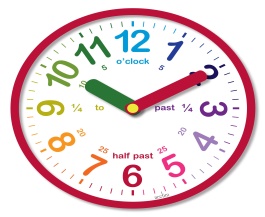





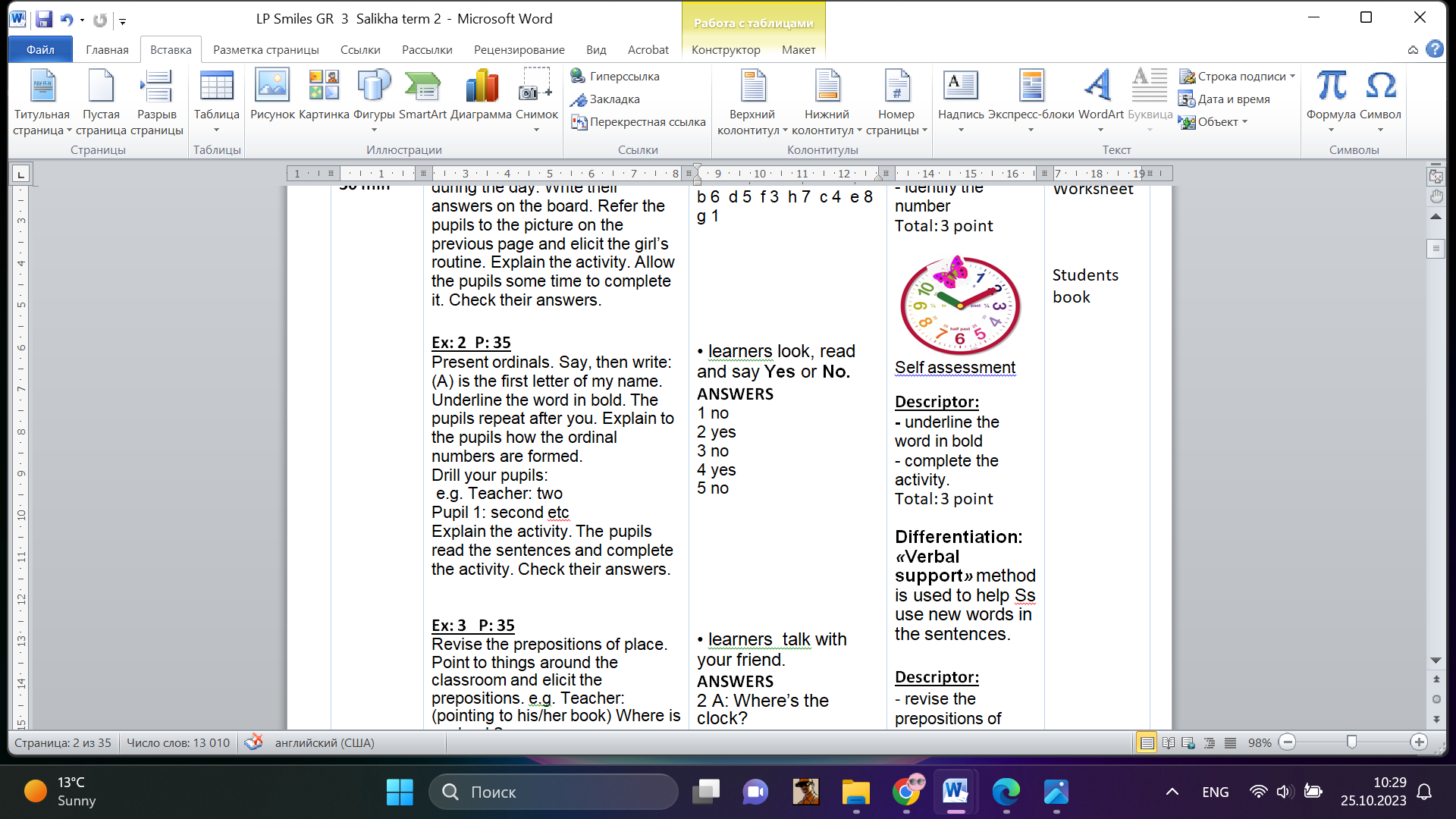


 •Pupils complete the sentences with the comparative form
of the adjective or adverb in brackets
•Pupils complete the sentences with the comparative form
of the adjective or adverb in brackets



